#power to classic and renaissance era princesses
Note
https://www.tumblr.com/the-sage-libriomancer/735649361333239808/rewatched-princess-and-the-frog-today-and-honestly
I saw this post and automatically thought of you. They are 100% correct.
Absolutely! You’re correct. Hey, @the-sage-libriomancer , I saw Wish and you’re still correct. The idea of having a star that is a higher power (Evangeline) and then having a character who demonstrates absolute faith in that higher power (Ray) and winds up teaching that same faith to both self-centered-Naveen and self-reliant Tiana? So very Disney.
Sometimes Disney’s Renaissance-era princesses were the Faithful Characters of their own story—Ariel had faith in Eric and taught that same faith to her father, Jasmine (and Genie) had faith in the Truth and taught that faith to Aladdin and the Sultan, etc. And that’s wonderful. Cinderella and Snow White are the Faithful Characters in their own stories, too, so it’s not like that isn’t a Classic Disney idea.
But Princess and the Frog doesn’t do that. It has the princess be the one who needs to learn to have faith. And the prince! That’s much more like dear old Pinocchio.
What Jiminy Cricket and Geopetto are to Pinocchio, Ray is to Louis, Naveen, and Tiana. I mean, how wonderful a tribute to Disney, to have the main character be afraid of relying in something higher, valuing love, and trusting only whatever she can accomplish on her own…
…to have her go from that to being willing to give up what she wanted? To value love, plain old love, over career, personal goals, dreams? To change her dream and admit when she was wrong? And finally, to sacrifice herself in order to do what’s right?
Why, that’s Pinocchio. That’s Mr. Banks from Mary Poppins. That’s Alice from Alice in Wonderland. That’s Disney!
Wish 2023 could never.
#Wish 2023#wish criticism#be my friend the-sage-libriomancer#Disney#Disney criticism#NotMyDisney#Not My Disney#RealDisney#The princess and the frog#princess and the frog#tiana#princess tiana#Naveen#Facilier#dr Facilier#Disney villain#Ray#Evangeline#the wishing Star#wish#asha#rosas
42 notes
·
View notes
Text
Frogs and Stars


As I have written before, Wish was unfairly criticized for a number of reasons. Some are understandable while the rest are just straight up dumb. One of these dumb criticisms is that Wish copies from the other and older "better" Disney movies before it, which I find hilariously stupid to begin with is because Wish was deliberately made to be an homage to those movies.
The film that it is most compared to is Snow White, given that Snow White is Disney's first animated feature and that Wish is a centennial film for the studio. Not the entire company, the studio that made most of the films Disney is famous for. It's important I specify that.
The reason why I find this comparison dumb is that it's just too easy. Snow White is a classic so any film released today by the same studio is gonna be compared by way-too-young boomers who think "old good, new bad". But there's one film that's more comparable to Wish as they're highly similar, The Princess and the Frog.
Now, I like Princess and the Frog. It's one of my favorite Disney movies. However, it has more problems than Wish, which I find funny given that PatF is praised for something Wish was needlessly hated for.
You see, PatF was made to be a return to the classic Disney formula that defined the renaissance era. So, stuff like it being hand drawn animated, romance, talking animals, musicals and a villain, are things that you think would make a good Disney movie. However, those things are the problem. They wallpaper over the films problems and distract you from them.
PatF has an otherwise good character focused story, but because it has the need to be a Disney Princess story, it has to include things the define the the renaissance era and complicated the plot. So things like Tiana being turned into a frog so she and Naveen must find a way to break the curse caused by Dr. Facilier all feel like they're there for the sake of the formula.
Coming back to Wish, both films have a similar theme about achieving dreams. PatF has Tiana preach about working hard to achieve her dream while Asha learns that people need to achieve their dreams themselves. Both characters don't need to learn a lesson as Tiana is forced to get a partner because of her status as a Disney Princess while Asha doesn't need to learn given that her motivations don't require her to.
Tiana gets nagged a lot by her own friends and family to settle down and get a partner, but her childhood friend Charlotte and eventual husband Naveen are highly supportive of her opening her restaurant that they both risk their own dreams for her. Asha already has a family and community she loves and she risked herself just so she can return the wishes that rightfully belong to them.
This theme extends to both films villains. Magnifico and Facilier cheat their way to achieve their goals as Magnifico lies and manipulates people to remain in power, Facilier lies and manipulates to gain power. Both tried to sympathize with their respective heroines with then understanding the struggles of an unfair world. However, despite being a popular and well liked villain, Facilier has a lame goal in comparison to the villains.
While most villains want to become a powerful ruler, kill someone out spite and jealousy or in the case of Gaston, forcibly marry a person not interest in them, Facilier wants to get rich. Despite literally having the powers of the Loa, he needs Lawrence disguised as Naveen to marry Charlotte so they can inherit her daddy's wealth. I mean, his power is limited and couldn't take over New Orleans if he wanted to, but that's just the result of the writers wanting to bring back villains but not knowing that kind of motivation he should have.
He also have a problem Rasputin has in Anastasia. Both are unnecessary villains who are there for the sake of the trope and don't even interact with the lead heroine til the climax. Tiana is only aware of Facilier from Naveen and presumably rumors about him given that he is nicknamed the Shadow Msn, suggesting he is a local shady figure.
His status as a popular villain is carried entirely but the aesthetics of Voudou and Keith David.
Magnifico on the other hand is a unique villain as most have a goal they want to accomplish, he already got his. He's already a king and in control of Rosas, in fact is only motivated is to remain in power and control, hence why he created the wish system. It's only after discovering that he could absorb the wishes for more power he wants Star for himself for their magic. He's quite simple compared to Facilier's complicated scheme.
Disney's films with a black main character have always been messy . Tiana was announced as the first black princess but was a frog for most of the movie. Ethan Clade is finally their proper gay main character in an animated film was forgotten by audiences due the lack of marketing. And Asha being misread as a selfish villain and only liked in fanon as the love interest to their imaginary golden boy.
Disney was criticized that they didn't commit into making Naveen and Tiana a fully black couple but Wish fandom is doing just that with Asha and Starboy.
At the end of the day, Wish and Princess and the Frog are films that have flaws, one just happened to have those flaws overlooked and the other accentuated.
10 notes
·
View notes
Text
World Three = The Fair Land Of Medievia
🏰👑👸🦄💂🐸🧜♀️🧚🧞♂️
~~~~
Jewel: Rhodochrosite
Power: Crystals
Color: Mauve
Theme: Fairytale Princesses & The Middle Ages
~~~~
Objective:
Go on a quest to save the fair Princess of Medievia from an evil dragon and bring her to her Prince Charming.
~~~~
Chapter III: Your Princess Is In Another Castle
~~~~
The third episode/chapter pays homage to the “Shrek” franchise from DreamWorks, the Disney Renaissance movies of the 1990’s, the classic fairytale tropes, fables, and nursery rhymes of your childhood, the medieval era kingdoms of the past, and the “bedtime story” movie plot from your favorite movies.
The episode begins on an unconventional note, where the first scene is that of a live action mom and her daughter getting ready for bed, while pop music plays in the background. The two talk about what a wonderful day it has been, as the daughter asks her mom to read her a bedtime story. As the mom rummages through some classic fairy-tales, she stumbles upon a mauve-colored storybook, of which she never read to her daughter before, and asks if she would like for her to tell the story of “The Kinger & His Knight”. Upon questioning about the alleged misspelling of the word “King”, the mom shrugs it off, saying she herself has never read it either and that she found it at a flea market one day. The mom decides to read the story to her daughter, starting with the iconic words: “Once upon a time…”
The camera zooms in to the interior of the book, where from here on out, the mom becomes this episode’s narrator as we meet Team Circus yet again in the Magical Digital Van, all while Pomni and Kinger sing along to “All Star” by Smash Mouth, with Caine behind the wheel, as usual. When Pomni excitedly asks to play the song again, Bubble, who is feeling anxious right now, says that she and Kinger have played that song six times already, with Jax replying that enough might be enough for them all. None of that matters now as Valerie (who had been on a phone call with Caine via one of the Communicator Bracelets) tells them that they have arrived at their next destination, The Fair Land Of Medievia.
Medievia looks just like a kingdom from the Middle Ages, with a beautiful castle, a medieval town, commoners walking amongst the beautifully-dressed aristocrats, all while sharing the same theme of the medieval era, with knights, princes, princesses, and bards. As Team Circus looks around in awe over how well-detailed this town is (the animation style of this place is reminiscent to that of the classic Disney movies), Caine and Bubble try to find a place where they can stay, using some of the money left over from the previous episode, and it's there that we are greeted by a traveling bard by the name of Stumpulot, a flutist who is in search of a permanent residence as well as a well-paying job, whom Pomni immediately befriends after sharing that the she and her friends also need a place to stay since they're tourists from a different area. The two proceed to sing about their new friendship and the things they share in common. (How exactly would that work? I don't suppose anyone would want to hear a Lizzie Freeman and Patrick Stump duet, do they?)
We cut back to the live-action daughter asking why this bedtime story is a musical all of a sudden, before the mom answers that it just is, before showing her the lyrics and music sheet of the song that Pomni and Stumpulot just sang. The daughter's only reply is a flat “Oh.”
We cut back AGAIN to Team Circus, who are having a lunch break in a tavern called “The Triskelion”, where Pomni and Stumpulot storm into the tavern, and they beg like little kids if he can join them on their adventure, puppy dog eyes and all. At first Caine refuses, voicing his skepticism from the last time they trusted someone, but after Ragatha and Jax of all people join in on the cutesy pleading, he gives in, and allows the bard to join them. Hooray!! Through Zooble's assistance, they were able to find a nice cozy area where they can stay for the night, called the Fox Inn. As Team Circus settles into their room for the night, Kinger puts on a movie via Bubble's communicator bracelet, and he chooses Shrek 2. Stumpulot comments that Medievia used to have such whimsical characters (i.e., the fairytale characters everyone knows and loves) back in the day before the King decided that they were simply too much and relocated them somewhere else in the kingdom. While Pomni tries to enjoy the movie, she can't help but think to herself what might have happened to these characters.
The next morning, at like 4:45 AM, the room service lady, named Janiss, wakes the still sleeping group to inform them that everyone in the kingdom (yes, even the visitors) are invited to the King's Grand gala to celebrate his daughter's Sweet 16 — already, they can tell just how unapologetically self-indulgent the guy is. Kinger is, for some reason, the only one excited because of his belief that he himself is royalty (as seen in the canon pilot), so this is his chance to actually impress someone like him, much to Caine's concerns. The two have a conversation as the others get dressed for the gala (eat up Royalteeth shippers!), with Kinger musing how much Queenie would have loved to attend an actual party hosted by a member of royalty, and Caine just praying that everything will work out in the end, as so far, nothing has gone wrong, which only fills the ringmaster with so much dread. Kinger remarks that this is the first time the two have actually talked like actual close friends since Queenie's abstraction and yet, there's still a rift between the two of them. The chess piece asks if everything is okay, to which Caine just responds with the usual “I'm fine”. Like he had been for years now. “Well, if you need anything, you can always come talk to me. I miss having you with me all the time.” Kinger replies.
Team Circus, now fully dressed like medieval characters at a ball, head towards the castle on foot, with Pomni remarking to Ragatha that Kinger hasn't acted like his kooky self since they got to Medievia, no dissociating, no easily being startled, and no short term memory loss. Perhaps it would be because this place makes him feel right at home, but she can't be too sure. Ragatha comments that while she isn't completely in the know, she has heard stories that Kinger used to be this grandfatherly figure that everyone looked up to, even Caine for some reason. The ragdoll can only hope that side of him will come back to him eventually.
With this, they arrive at the castle gates, to be greeted by a plump, Santa Claus-esque man dressed in silver, pale blue, and periwinkle, all while wearing a golden crown, who introduces himself as King Cloudbeard, through excited handshakes for each of the members of Team Circus. As they walk inside the castle's throne room itself, they are greeted to a large crowd of equally dressed guests of the kingdom, from other royals, to nobility, the working class, the commoners, and even the most destitute of peasants, all with varying degrees of color and flamboyance. The throne room is decorated with a sparkling gold and diamond-encrusted chandelier, with at least four tables of different gourmet snacks to try out, with an empty giant plate being reserved for the princess’s birthday cake for later. Speaking of the princess, King Cloudbeard’s daughter, Princess Purity, is listlessly listening to the cacophony of the party, wearing that cliché Disney Princess face of “wanting more out of life than her privileged upbringing” on her designated throne next to her father's. King Cloudbeard is happily asking how Lord Spaniel and Lady Fowl, two nobles of Medievia, are enjoying the party, which only gets eyerolls from the lord and lady, making the King's face droop with sadness.
An hour and 45 minutes pass, and Team Circus is most enjoying themselves, with the occasional influx of new guests arriving, the sound of minstrels playing different songs on their flutes, fiddles, lutes, and drums, thousands of conversations, debates, and arguments filling the air, and the damn chandelier blinding those who look at the lights for too long.
Stumpulot and Pomni take a look around the throne room and find themselves enamored with the food in the table, which consist of sliders, green bean casseroles, slices of honey glazed ham, brownies, cookies, raspberries, blackberries, cherries, thousands of plates, forks, spoon, knives, sporks, and cups, in one section of one of the four tables, and four punch bowls consisting of pink lemonade, regular lemonade, Dr. Pepper, and grape juice each, among others (to which diplomat Rionna curtly retorts that all that good food is making her hungry). When Pomni finds the King sulking near one of the food tables, she asks what's wrong, to which he replies that none of the people he wants to impress is actually enjoying the party; not even his daughter is in the spirits. Stumpulot then asks what's the giant plate for, to which the King answers it's for the birthday cake that's being presented very soon. Stumpulot and the King hit it off with each of them explaining their backstories to each other (the King's wife died recently while Stumpulot is homeless and in need of a place where he can belong) and sharing things they have in common, like wanting to make people happy. Pomni is just munching on the sliders as she watches.
Kinger takes a moment to admire the scenery, when he stumbles upon the lord and lady King Cloudbeard had just talked to. Kinger attempts to make small talk with the two, only getting snide insults from Lady Fowl as Lord Spaniel just waves his fan like a stuck-up prick. Another song ensues from the two, and it's treated like a diss track of some sorts. Gangle and Zooble are just hanging out with each other, as well as Ragatha and Jax, while Caine just stands amongst the crowd, trying to find something to do amongst the environment of bright lights, loud noises, and unfamiliar surroundings. Pomni finds her best friend Caine being idle and offers him a slider, which he politely declines. She asks what's wrong, though he tries to reassure her that he's okay, despite looking like he wants to get the hell out of here. The two have a heartfelt conversation, with Caine revealing why he doesn't know why he feels like this, or why he feels like he's always been this way, with Pomni trying to reassure him that he's not alone.
At last the birthday cake arrives and the whole crowd goes silent, with Princess Purity looking like she just witnessed a murder or something. Stumpulot catches up to Pomni and Caine as the royal chef prepares all sixteen candles (it's actually eighteen candles; the extra two are the 1 and 6 candles respectively), while King Cloudbeard makes a speech about how his daughter is finally growing up into the woman he knows she can be, mentioning how he wished his wife could be there for this momentous occasion, as he declares the whole reason why he invited everyone to the gala was so he can choose a proper suitor to marry off to the princess so she can rule Medievia one day, shocking, dismaying, and even disappointing the crowd that they had been lied to. Team Circus is noticeably not amused by this notion, with Ragatha declaring skepticism over the whole situation, only for him to justify that he had been betrothed to his wife at the age of 16, and his father before him, and his grandmother before him, and so on and so forth; it's an unyielding tradition that has been held up for generations. Princess Purity, enraged that her life is being decided for her, calls out King Cloudbeard for not even allowing the freedom she deserves, which he again tries to justify that he only wants to protect the only remaining remnant of his deceased wife. The crowd is now murmuring amongst themselves, with Lord Spaniel and Lady Fowl looking at the King in venomous disapproval, much to the latter's horror on his face as he still tries to double down on his beliefs. Furthermore, it's revealed by King Cloudbeard in the increasingly heated verbal fight that the reason why the fairytale-esque characters are no longer in Medievia was because the Queen was killed by one when the Princess was just 14, much to the shock of everyone. Stumpulot gestures to Team Circus that they should leave as things have already gotten awkward enough. The party continues on without them, although the atmosphere is a lot more tense and somber with Princess Purity looking defeated.
Two more hours pass, and we are greeted to a scene with the princess, who is looking at the golden afternoon sky as she holds a goblet of grape juice in her hands, pensive about her outburst. Wanting to apologize for stepping out of line, she attempted to go back to the party, only to bump into a distinguished and handsome gentleman, a member of royalty by the name of Prince Steele. Noticing she just ruined his suit, Purity apologizes profusely, only to tell her that it's okay and that it was an accident. When he asks what's wrong, she tells him that she feels really bad for letting the secret out about her mother’s death and the resulting persecution of all whimsical characters in the aftermath, something she feels incredibly guilty over. He tells her that it's not her fault that her dad decided to be rash about certain things, only for her to tell her that he had always been this way, even before the Queen’s untimely murder, but tries to excuse it as the King just wanting to protect his daughter. The conversation continues with Steele revealing that he also has a harsh but loving mother that he wishes would understand things the way he does, leading to the two having their romantic “I Want” duet, waltzing and all. The song ends with a tiny hint that the two may have fallen in love with each other as they say their goodbyes, with Purity and Steele heading off in separate directions.
Immediately after, the screen fade transitions to Team Circus finally arriving back at the Fox Inn. Stumpulot apologizes for the botched party visit, which Pomni brushes off as a minor inconvenience (after all, she's experienced much worse back at the Amazing Digital Circus). Caine, who has remained silent throughout the whole journey back, just plops onto one of the beds and shuts off for the night. As Stumpulot and Pomni converse with each other, he reveals that he was originally born in the same place where the fairytale characters were relocated/exiled to, and has heard the story of how the Queen was murdered:
When the King and Queen took their daughter to see a play in the nursery rhyme district of Medievia, they were ambushed by feline crooks, similar to Puss in Boots, had all their possessions stolen, with Princess Purity and her mom, the Queen, being held hostage by the leader of the crooks. King Cloudbeard fought them off as best as he could, but in doing so, he watched the carriage he, his wife, and his daughter were in, get engulfed by flames. We are treated to a scene of the Queen shielding her daughter from the flames as she screams in agony, with King Cloudbeard wailing in grief. Shortly thereafter, the King signs a paper that declares that every last fairytale creature be relocated so that he'd never have to be reminded of what he had lost again. Pomni is horrified by the story (and even shedding tears), but still reminds herself that it doesn't excuse his harsh treatment of the fairytale characters. Stumpulot can only hope that the King changes his mind and apologizes for his mistakes, as everyone else goes to sleep for the night.
We cut back to Princess Purity, who is in her room eating a slice of her birthday cake, when she happily declares to herself that she's finally made her first friend after being isolated from everyone else her whole life. We then get a POV shot to a first person view of a mysterious thug, who knocks down her room’s door, approaches the princess as she frightenedly asks who they are, and the screen fades to black as she screams in terror.
The next morning, as Team Circus sulks throughout the Medievian village, tired from yesterday's events, they are all greeted by King Cloudbeard and Prince Steele (the latter of whom they have not met before), who have run on foot to ask for help. Understandably, Team Circus refuses to buy into their claims, citing that it was his fault for the birthday party gone wrong with his incessant insisting on his warped ideas of love, until they are introduced to Prince Steele, of whom the Princess had already chosen as her suitor, immediately subverting expectations much to Team Circus's disappointment, thinking that the King got to her head. Steele, after hastily introducing himself to the others, tells that the Princess was kidnapped by some unknown thugs. Thinking it might be those “pesky fairytale hooligans” again (which Stumpulot takes great offense to), he asks them, or rather demands them, to go to the Fairytale lands where the Princess might possibly be. It's a dangerous and arduous journey, with dark forests filled with creepy crawlies, temptations galore, and above all, villains lurking in every corner. As a result of Steele’s pleas and begging, all eight members of Team Circus receive a notification for their third objective on their communicator bracelets, meaning that they can no longer refuse the offer to help. Having been through a lot worse, Team Circus happily obliges, since that also means the possibility of finding the third jewel on their journey.
And so, the set off into the fairytale lands, such as the hill with a watering well (Jack and Jill), a gingerbread house (Hansel & Gretel), a mansion made out of straw, twigs, and bricks (Three Little Pigs), and even an ice castle (The Snow Queen), all while “Holding Out For A Hero” by Bonnie Tyler plays. The music only stops via a record needle scratch once Kinger declares that they've been going in circles the whole damn time after experiencing deja vu with some of the locations, most specifically the gingerbread house that caught Pomni’s eye. Understandably, Caine is ticked off, screaming into the sky in frustration, alerting a group of fairytale characters lead by a large troll with an apparent Scottish accent, a girl wearing a red hood, and a beast wearing a golden crown and a tattered suit, who is carrying a jewelry box with him. The red hooded lady asks if there seems to be a problem, to which Prince Steele replies yes in a quick manner, hyperventilating about the missing princess.
The trio are not happy because of their disdain for royalty after they somehow got banished for no apparent reason, as the bridge troll exclaims. The beast prince reveals that he had tried to rescue a princess once, but doesn't specify further details even when Pomni asks. When Jax frets over getting lost again (out of mostly exasperation, of course), diplomat Pamela teleports a map of the fairy-tale lands, where supposedly they'll be able to rescue the princess, and hopefully not get lost. “You mean to tell me this whole time you HAD A MAP!??!?” Caine yells out.
But before the overwhelmed ringmaster could get mad further, the map projects the locations in which they'll need to cross in order to rescue Princess Purity: The Blackberry Forest, Wonderland Lane, The Cave Of Covetousness, Mermaid Lake, and lastly, The Princess Tower (convenient naming there, eh?). The others are understandably frustrated by the cliche naming of where the princess could be held hostage. Before they could start their journey, Stumpulot introduces Team Circus to the new trio as Lynnard the Bridge Troll, Red Riding Hood, Prince Draught, and lastly, the Genie Of The Box, who is currently taking a nap in their cozy safe space that beast prince is carrying with him. Without further hesitation, Team Circus, Stumpulot, Prince Steele, and their new allies set a course for the Princess Tower, where Steele’s newfound love will be rescued.
As Team Circus heads off to their first location, each of the new allies have a pleasant conversation with the members of Team Circus, who all explain their own backstories to the fairytale friends, who in turn explain their backstories to the others, as well as Steele and Draught getting along splendidly. Kinger and Caine are also having a personal conversation of their own, having overheard Steele’s love story to Draught in the commotion, and the latter expressing suspicions to Prince Steele as he's not entirely too keen on the idea of love at first sight, despite Bubble’s interjection of the contrary (the sentiment antivirus software had indeed fallen in love at first sight himself), claiming that just because Caine doesn't believe in love at first sight, that doesn't no one else should believe it either. Before the conversation can progress further, they arrive at their first hurdle: The Blackberry Forest.
Yup. The Blackberry Forest is your typical scary dark forest seen in fairytales! It's pitch black in there, if it weren't for the flashlight feature on Pomni's communicator bracelet. Stumpulot warns the others of man-eating creatures known as Deermen and that any sudden noise could alert them to any “fresh meat”, recalling a time when he and his unnamed brother were playing around in the forest, only to get almost killed by one of the Deermen after they were being too loud that day. At first, they all try to remain as quiet as possible, with the occasional stepping on a twig, tiny yelps in fear, or even a simple gust of wind, until Prince Draught trips on a tree root, yelps out over dropping the jewelry box, alerting a Deerman of the group's whereabouts. As Prince Draught tries to find the jewelry box in complete darkness, Team Circus, Stumpulot, Red Riding Hood, and Lynnard, try to dodge the Deerman’s attacks, before Prince Draught decides to use his beast form to defeat it and protect his buddies, all while everyone tries to escape the forest. Ragatha finds the jewelry box while Jax finds a small ray of light, which leads out of the forest. As everyone else escapes, Prince Draught is seemingly lost to the Deerman. However, they have no time to grieve before they venture off to Wonderland Lane, albeit still in shock over the ordeal.
Wonderland Lane is, for lack of a better term, brain aneurysm-inducing, as its confusing twists and turns lead them to different areas of Wonderland Lane, from a mad hatter’s tea party, to a white rabbit’s house, to singing and talking flowers, and ultimately a rosebush that's been painted red. Pomni has already been accustomed to getting lost in liminal spaces, and thus is good at finding a way out of particular mazes, especially the whacky and colorful ones like this, for example. Caine, Kinger, and Bubble are struggling to get through the painted rose bushes, Jax and Ragatha are forced to participate in a tea party of craziness, hosted by the Mad Hatter and a talking hummingbird (instilling deja vu from Jax and Ragatha), Gangle and Zooble are navigating their way through a multicolored dog park (Gangle gets distracted by the cute puppies as a result), Pomni and Stumpulot are forced to escape a corridor of doors with doors (doorception) after attempting to ask for directions from a white hare, and Lynnard, Prince Steele, and Red are dragged into a flower concert, where it turns out the flowers are tone deaf. This is all while “One Little Slip” by Barenaked Ladies from Disney’s Chicken Little plays. But eventually, they all reunite, but not without falling into what appears to be a similar-looking rabbit hole from the Alice in Wonderland story they just witnessed, where it promptly leads to them getting trapped to their next location, the Cove of Covetousness.
Bubble complains exasperatedly that the map is stupid, just as everyone realizes that they lost the jewelry box. Once Caine and Pomni find the box, it's slightly damaged with the encrusted gems having fallen off and being covered in mud from the ordeal. Lynnard tries in vain to warn the two not to rub the box, but it's too late; after Caine cleans off the mud, the box opens to reveal the aforementioned Genie Of The Box, saying this introductory line: “Good morning, Vietnam! …Wait, this isn't Vietnam.”
Yeah. It turns out that the reason why the Genie was kept in stasis was because of how annoying she is. And this goes on for a long time, with the Genie chatting up a storm, as everyone else tries to find a way out of the cave. Arguments ensue from this. But before any of this escalates, the Genie points towards a door that leads them out of the treasure portion of the cave, leading everyone to stop what they're doing and realize that they were being stupid. The typical “easy solution is eventually found for comedic effect” schtick. As they walk the temple-like halls, the Genie and Stumpulot have a heart-to-heart, with the Genie's origins finally being explained to the audience as everyone else has their own conversations in the background. The cave of the Cove of Covetousness leads to an underwater section of the area that is Mermaid Lake, where, thanks to the Genie's underwater breathing bubbles that serve as helmets to everyone, they swim up to the surface and find the Princess Tower from afar, along with what appears to be a dragon.
The Genie conjures up a boat after Pomni accidentally wishes for one, before stating she has 22 wishes left. When Kinger asks why 23 wishes, Red answers that as annoying as the Genie is, she's fairly generous. Stumpulot, wanting to save what sanity is left for everyone, shuts the box, promptly putting the Genie back into stasis mode. They finally arrive at the location of the Princess Tower where Prince Steele eagerly gushes over Princess Purity's rescue. Stumpulot wonders how they'll be able to get past the dragon, but Steele recognizes the dragon as an old friend of his named Vermilla in his childhood days and the two catch up on the latest events, (much to everyone's confusion, anger, and shock as this was information that was never before revealed to them), and decides to talk to dragon, all while everyone tries and finds a secret entrance to the tower. Kinger briefly glances from behind what seems like a sinister grin, but brushes it off as yet another digital hallucination.
As the others trek their way through a cave-like corridor in the tower, they find another character who appears to be trapped in a dungeon-esque chamber. This character also appears to be of royalty, but looks strangely beaten and tattered, with a look of trauma on his face. He desperately warns them to turn back, and while Kinger, Stumpulot, Lynnard, and Red all look horrified and are convinced to leave at once, Pomni insists on continuing as they have a mission to complete. They all have completely forgotten the objective as a result of everything that went on beforehand, and as Jax tries to find a way to bail out the new character with his arsenal of keys, they find a spiral staircase that would supposedly lead to the rescue of the Princess…
…Instead it would lead them to a trap. Goddamnit. Welp, you know what they say, fool me once, shame on you. But fool me twice… damn. It's revealed that Princess Purity was never kidnapped and trapped in the tower at all and that it was all a set-up for what the princess and King were about to do. You see, when the princess was “kidnapped” the kidnapper turned out to be Prince Steele himself. Rather than getting mad, she found it rather hot that Steele would go all this way to scoop her up in his arms, take her away from her boring comfy life, and let her live a simple life away from the palace. She's essentially a careless prick who doesn't care about what's best for her people, and only cares about herself, a typical poorly written Disney princess move. Meanwhile, Prince Steele, after marrying Princess Purity, will become the next King of Medievia after King Cloudbeard enacts his genocide on all the fairytale characters. The fairytale characters were already suffering from bigotry and discrimination long before Medievia existed, and was essentially conquered land that had rightfully belonged to the fairytale characters before being taken away from them. The Queen had objected to the genocide, which angered King Cloudbeard, so he staged the hostage situation in the hopes of getting rid of the Queen, which he successfully did, knowing fully she'd protect his other expendable asset (his daughter, the Princess) so he can finally get some use out of her and enact his grand plan to make Medievia pure. And Purity was okay with all of this, because she cares about absolutely no one but herself, and had always been a spoiled brat that not even her own mom could tame. Plus, she loved her dad more, Purity claims.
And that's when King Cloudbeard emerges from the shadows, still putting on his faux happy persona, although in a much more condescending tone than anything. It turns out he had been following them from the start, using an invisibility spell on one of his signature crowns. We're treated to another flashback Prince Steele meeting King Cloudbeard for the first time, where he reveals his genocide plans to him alongside Lord Spaniel and Lady Fowl, who are actually war generals outside of public knowledge, and Prince Steele reveals that he's third in line to the throne of his own home kingdom, thus having virtually nothing of value, and has been desperately seeking a royal's hand in marriage so he can rule over his people someday. Steele had noticed moments earlier after their little duet that Purity had fallen in love with Steele and asks for the King's blessing, to which the King agrees, as he's in dire need of a public figure to turn the public's attention away from the fairytale “cleansing”.
Jax manages to finally find a key close enough to break the new character out of his cell, just in time to catch up to the others, only to find out it was all a scummy lie, when Cloudbeard, Purity, and Steele continue their villain monologue. Stumpulot, not believing for a sec who he's seeing in front of him and with tears in his eyes, attempts to rush towards Dice for unknown reasons before being stopped by Steele. Cloudbeard introduces Team Circus and the side characters to Prince Dice, twin brother of Prince Draught, with Draught having been turned into a beast after his kingdom was annexed by Medievia and his brother Dice being imprisoned in an abandoned tower ever since, to be guarded for all time by a chatty dragon named Vermilla. Another flashback shows how Prince Draught said he tried to rescue a princess once. Said princess turned out to be his older sister, Princess Purity's mom, the Queen of Medievia, who was forced into marriage by King Cloudbeard after her homeland was conquered by his Medievian army, including images of Lord Spaniel and Lady Fowl holding her hostage. This meant that Draught and Dice are Purity’s uncles, something that she herself knew since she was 12 years old, but the others didn't, mainly because of the minimal foreshadowing.
The wedding will be happening tomorrow night, Cloudbeard declares. Kinger asks angrily why they chose them of all people, to which Cloudbeard responds that they reminded him so much of those “disgusting abstracted lowlives'' that plagued his beautiful kingdom, and wanted to give them a first row seat to his conquest, out of sheer sadism and to send a warning to everyone to never cross the King. The word “abstracted” strikes a chord for all eight members of Team Circus, with them freezing up in disturbed horror and fear for their survival. When Lord Spaniel and Lady Fowl also emerge from the shadows to take the others out of the towers and throw them into the dungeon cart that Cloudbeard had drove in, Stumpulot snarls that they won't get away with this, to which Steele retorts back that they already have. As Team Circus and all the others are locked up in the cart, Pomni glimpses at Vermilla, who looks like she had no idea that any of this would happen and looks remorseful. We don't see her again until the climax.
Everyone looks forlorn and defeated, except our beloved jester herself, who is quick to point out that the Genie can get them out of there and stop the marriage, but no one responds. Pomni rubs the box again, and we are treated to the Genie saying her catchphrase for the second time: “Good morning, Vietnam!!! …Nope, still not Vietnam.”
Pomni pleads/wishes for the Genie to let them out of the cart, but when she tries, she finds that it's magic-proof. Jax tries to find a key that'll unlock the cage, to no avail. Not even Ragatha’s hairpins can unlock them. Zooble tries to use all of their strength to bend the metal bars, (only to fall apart within seconds), Gangle uses her ribbons to break them apart, and Bubble tries prying them off the cart with his teeth.
While everyone else is trying to open the cage in their own manner, Stumpulot and Prince Dice have a heartfelt talk, saying how much they missed each other, even though they’re sorry that they had to reunite like this. They reveal some minor info about each other, including the memories they used to have when they were younger, including a sweet reprise of the first song in the episode, which culminates to this…
Stumpulot reveals to everyone actually used to be a jester for the twin princes before their kingdom was conquered by Cloudbeard. This causes everyone to stop in their tracks to listen. Stumpulot says that he's the great grandson of the Pied Piper, hence why he has connections to the fairytale characters, and that the conquered kingdom in question is the fairytale lands, specifically where Wonderland Lane currently is in question. Stumpulot was there to witness the entire invasion, the capturing of Prince Draught and Prince Dice’s sister, Princess Checkers, the ensuing war, and the death of his family and even the Prince’s mom and dad. His only remnant of his family was the pipe flute his great grandpa had amongst the ruins of what used to be his home. So he ventured near and far to try to find a new one, not realizing until just now that he had wandered into the kingdom that took everything away from him, except he doesn't have the energy to be angry anymore because of what's about to happen tomorrow morning. Everyone shows sympathy for the two of them, even the menace-to-society Genie can't help but feel awful. The atmosphere becomes solemn and quiet as they can only pray for a miracle to happen.
At sunrise the next morning, we see Prince Draught, who looks like he's seen better days, having already tamed a Deerman, and trying to find his way back to the group, only for him to realize that they unintentionally left him behind thinking he was dead, although none of that matters now as he spots a dungeon cart, carrying with him his allies… and his long lost brother. He looks on in horror as his keen hearing brought to him by his beast form allows him to overhear a conversation about how King Cloudbeard’s plan to kill off all the fairytale characters is going according to plan. It's disguised as a heartwarming scene where Purity reveals that she didn't like the idea of marrying at 16 because of how young it was, but after finally finding her hero, her Prince, she can safely say that she was wrong about the whole youthful arranged marriage thing being bad because it means she gets to spend the rest of her life with Steele, and live a prosperous life without the “subhuman caricatures'' that keep getting in the way of Purity’s selfish desire for a simple life and Steele's desire for a throne to sit on.
Draught sets off back to the fairytale lands to warn them about their impending fates.
At an almost-in-ruins fairytale village Prince Draught tries to gather up as much fairytale characters as he can to rescue his allies and stop the genocide of their people. They're all angry that their suspicions have been confirmed and all set up to revolt against the King and maybe stop the wedding in the meantime. They all sing a song about how they knew it all along and how they won't let them take away what little they have left to call home. Characters include Henny Penny, Big Bad Wolf, the Three Little Pigs, Hansel and Gretel, Goldilocks and the Three Bears, Puss in Boots, Pinocchio, The Ant Queen and The Grasshopper King, Snow White, Cinderella, Sleeping Beauty, Rapunzel, even the Mad Hatter and his hummingbird assistant, the White Hare, the Queen Of Hearts and her card bodyguards, and many, many others. Prince Draught has officially rallied up an army to revolt against the system.
Meanwhile, as the rally song continues to play, after King Cloudbeard announces from his balcony to his subjects that the princess has finally chosen her suitor and that the wedding is in 15 minutes, Purity gets dressed for her big day and in a wholesome (but still evil) moment where she hugs her dad and tells him she loves him, as he walks her down the aisle, to the altar where Prince Steele is, as well as Archdeacon Bishop, who is marrying the two off for the wedding. Thousands of other Medievian citizens are seated at the wedding church benches, along with a battalion of guards to make sure nothing goes wrong, the tied up members of Team Circus, Stumpulot, Lynnard, and Red, although for some reason, the jewelry box the Genie Of The Box is sleeping in isn't even remotely secured, which Red takes notice of very well and tries to discreetly knock off the seating without anyone noticing.
Just as the song ends, Prince Draught boldly shouts that King Cloudbeard's reign of terror ends here, to which the latter responds calmly and ominously that he had expected something like this, which was why he brought company, revealing a hundred more guards from behind the altar. After an action packed scene of the fairytale characters being badass (both individually and in groups), Red finally knocks the box down, breaking it for good, prompting the Genie Of The Box to say her catchphrase one last time: “Good morning Vietn— holy moly, that's one way to crash a wedding…” Ultimately, the Genie gets the tied up folks out with her magic after Red wishes for their escape, which she happily obliges.
The civilians are unfortunately caught in the crossfire, even those who secretly opposed the King’s rules. Team Circus, Stumpulot, and the fairytale allies all try to bail out the civilians to safety, while Prince Dice confronts the King himself, which results in a dual battle while the commotion continues in the background. Meanwhile, Purity, Steele, Spaniel, and Fowl find Team Circus and promptly try to stop them, only for the fairytale allies to retaliate by brute force, eventually getting Kinger, Jax, and even Ragatha to join the fight.
Eventually, the battle ceases with a victory from the fairytale characters by a landslide, the soldiers either being injured or killed, and Dice and Draught finally reunite, with the King refusing to accept defeat as he declares that as long as he continues to sit on the throne, he will always win in the end… that is until Vermilla the Dragon breaks into the wedding altar where the King is standing, and unceremoniously eats King Cloudbeard, ensuring his permanent loss once and for all.
It's a scene reminiscent of when Sir Pentious from Hazbin Hotel was killed in an anticlimactic fashion by Adam, and Charlie awakens her ultimate form from grief as a result. Here, though, it's a parody of that, with Princess Purity running towards where her father used to be and weeping just like a Disney princess, Steele goes on to comfort Purity, with Lord Spaniel and Lady Fowl expressing sorrow for the King's death, in a saccharine parody of those sad Disney death scenes.
But just as Steele and Purity are about to sing a reprise of their “I Want” duet from earlier, Vermilla the Dragon, sick of their bullshit, just straight up eats all four of them too. At least Purity went out like a true princess. This causes Zooble and Jax to erupt into laughter from the sheer absurdity and anticlimactic manner of the whole thing, while everyone else just stares in confusion and shock.
Afterwards, Team Circus rejoices in Prince Draught’s survival after catching a glimpse of him alongside Dice, with Red, Lynnard, the Genie, and Stumpulot all having a bittersweet reunion with the long-thought-to-be-lost Prince Dice. Team Circus joins in on the reunion as they all catch up with each other as they, the celebrating fairytale characters, and the Medievian civilians walk out of the church and celebrate the end of King Cloudbeard's tyranny.
Later that evening, a wild celebration outside with fireworks ensues, with Team Circus, Stumpulot, their newfound allies, and all the other fairytale characters enjoying their newfound liberation when a faint desaturated pink glow can be found within a tree hollow behind them, which Pomni notices. She finds the source of the light and finds their next jewel, prompting all eight members of Team Circus to receive this pop-up notification:
~JEWEL OBTAINED!~
2 out of 26
Only 24 remain
The jewel is a beautiful mauve-colored Rhodochrosite.
This unfortunately means that it's time for them to leave. When Lynnard asks, “Can't they stay?”, Stumpulot replies that they're not from here and have a home to go back to. Team Circus share a heartfelt farewell with their new fairytale friends as they all get back to the Magical Digital Van, content and a little amazed with having just saved an entire nation from a tyrannical ruler — though that wouldn't have been the first time they've done so, Jax claims.
The whole journey, the mom narrator has been reading out the entire episode like a fanfic of some sorts, and as the Van drives off into the starry night, the camera zooms back out of the storybook as the mom finishes with “...and the newly freed dwellers of Medievia all lived happily ever after. The end.” The daughter exclaims how awesome the story was, which the mom agrees. The mom tucks her daughter into bed and kisses her forehead, with them both saying goodnight to each other before the mom walks out the door and turns off the lights.
When the coast is clear, the daughter promptly grabs back the book that was put away moments ago, grabs a flashlight, and rereads the book under the blanket covers, as Smash Mouth’s “All Star” replays for a second time while the credits begin rolling.
The episode ends with this In Memoriam dedication:
In loving memory of our all star
Steve Harwell
1967-2023
~~~~
Current Status:
2 Jewels have been collected
24 remain
🏰👑👸🦄💂🐸🧜♀️🧚🧞♂️
~~~~
• OG Cast
Lizzie Freeman as Pomni
Amanda Hufford as Ragatha
Michael Kovach as Jax
Sean Chiplock as Kinger
Marissa Lenti as Gangle
Ashley Nichols as Zooble
Gooseworx as Bubble
Alex Rochon as Caine
~~~~
• Audience Surrogate Cast/Diplomats
Hynden Walch as Valerie
Susan Egan as Pamela
Amy Winfrey as Garcia
Mandy Moore as Lulu
Nevaeh Hamilton (me) as Bethany
~~~~
• Background Diplomats
Andrea Libman as Winona
Cristina Vee as Patricia
E.G. Daily as Rionna
Stephanie Sheh as Olivia
Debi Derryberry as Yolanda
Cree Summer as Gemma
Ashleigh Ball as Cécelia
Erica Luttrell as Belle
Ashly Burch as Imera
Kimberly Brooks as Bailey
~~~~
• Episode’s Antagonists
Jim Cummings as King Cloudbeard
Jodi Benson as Princess Purity
Paige O’Hara as Lady Fowl
Michael Jelenic as Lord Spaniel
Aaron Horvath as Archdeacon Bishop
Ed Sheeran as Prince Steele
~~~~
• Secondary Characters Introduced
Angelina Jolie as Mother/Narrator
Vivien Lyra Blair as Daughter
Mike Meyers as Lynnard the Bridge Troll
Chloë Grace Mortez as Red Riding Hood
Nevaeh Hamilton (me) as Genie Of The Box
Jimmy “MrBeast” Donaldson as The Beast/Prince Draught
Patrick Stump as Stumpulot the Bard
Adam “SomethingElseYT” Ortiz Jr. as Prince Dice
Alan Tudyk as Mad Hatter
Melissa Fahn as Hummingbird
Rob Paulsen as White Hare
Tiffany Haddish as Vermilla the Dragon
Alex Borstein as Janiss the Room Service Lady
~~~~
#the amazing digital circus#tadc#the amazing digital road trip#tadrt au#tadc road trip#tadc au#tadc pomni#tadc jax#tadc ragatha#tadc kinger#tadc gangle#tadc zooble#tadc caine#tadc bubble
10 notes
·
View notes
Text
I swear, they approached Disney's 100th anniversary film all wrong.
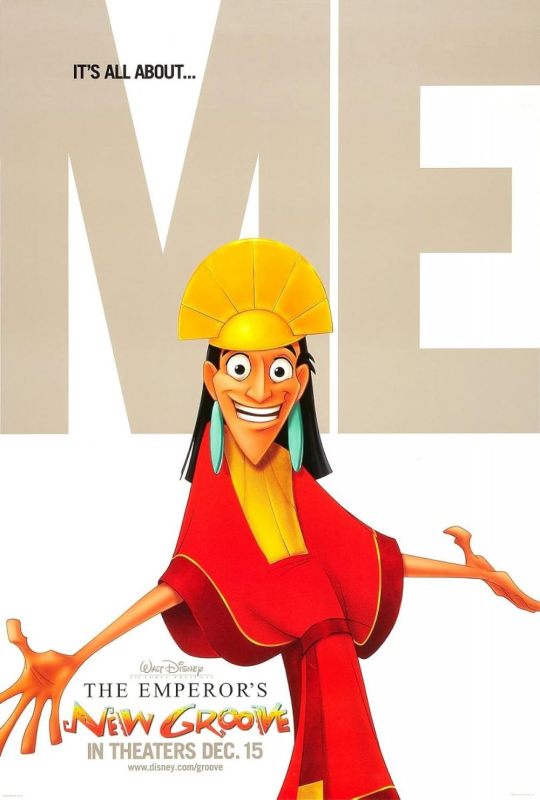
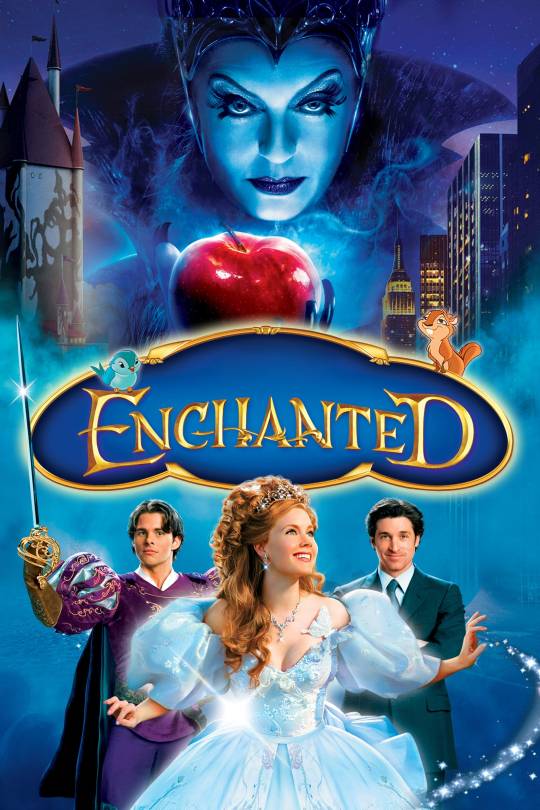
The best part about "Wish" were the easter eggs, and even those were hit-or-miss. The plot didn't scream fairy tale or Disney--and neither did the music; if I never knew this film was a Disney film, I'd say it was a company's first attempt at an animated film. As a first attempt, it's not bad, but as Disney's 62nd film and an ode to 100 years of business....I was heavily disappointed.
I've made posts about how this could've been another epic Disney film, but for this post, I wanna try another angle, with two different ways Disney could've approached this celebratory film.

Option 1: A parody. Looking at "Enchanted", AKA one of Disney's best live-action films, the movie makes fun of classic Disney tropes as well as paying homage to renaissance-era films, which at the time this movie came out, was Walt Disney Animation Studio's biggest successful period. A film about a naive animated soon-to-be princess who is banished to the real world discovers what she wants out of life, all while charming those around her. I'm not saying "Wish" needed to include the real world aspect, but having a parody about a princess (or prince) who comes off very early-Disney while still feeling modern and giving us Disney-esque tropes and a fun story would've been a great vibe. Imagine if Asha is naive and easily taken advantage of by King Magnifico, who teaches her magic and manipulates her into harming others, seeing her youth as a weakness ("Well, you're young. You don't know anything, really."). Imagine the story actually having her BE a fairy godmother, albeit in training, and she has to learn the price and limitations of wishes (very "Cinderella"-esque) and learning when to help and when not to help others. It'd be mature and magical at the same time! Plus I imagine Magnifico being a cross between Narissa and Gaston. Amaya would probably be non-existant or an admirer Magnifico uses.
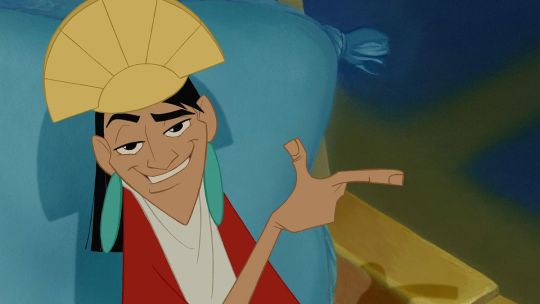
Option 2: A cutting, modern take on a classic. While I'd rather have "Kingdom of the Sun," "The Emperor's New Groove" is a funny and irreverent story about a selfish Inca Emperor who's turned into a llama by his power-hungry advisor and must return to the palace while learning to care about others along the way. Kuzco, in contrast to most Disney protagonists (or most protagonists in kids/family films in general) starts off petty, untrustworthy, and self-centered, but these qualities also give way to cleverness and humor, something that most Disney heroes lack due to either their innocence, kindess, or seriousness. Kuzco continually comments on things around him with quips and remarks that go unnoticed by the general populace (thanks to breaking the 4th wall), and it got me thinking, what if Asha was like this--or better yet, Magnifico? What if Magnifico wasn't a villain per se, but a selfish and mean king who continually had pessimistic comments to make about this fantasy-esque kingdom he created and his airheaded inhabitants. Their growing dependence on him--as well as their happy-go-lucky attitudes make him constantly patronize and devalue them, and his attitude accidentally causes destruction for the kingdom. When Asha challenges his perspective and goes on an adventure to bring back his love for others (trauma does run deep for him), he learns that everyone has a wish worth granting, and that he shouldn't be so quick to look down on others because they still have the joy and innocence he lost. Plus the people of Rosas learn not to take advantage of others and appreciate the things they have. Magnifico being like a cross between Yzma and Kuzco would be a sight to behold, while Asha takes on more of a wise Pocahontas-type role.
I can't be the only one who thinks this was a better approach to "Wish" if they didn't want to do a typical epic film.
21 notes
·
View notes
Text
Hayao Miyazaki’s ‘The Boy and the Heron’ opens to record-breaking $12.8 million

“The Boy and the Heron,” a fantastical coming-of-age story from animation maestro Hayao Miyazaki, earned $12.8 million in its opening weekend, becoming the first original anime production to top the domestic box office. The GKids release is showing in Imax and other premium large format auditoriums, which bolstered its record-breaking revenues and helped secure its first place finish. It also benefitted from a lack of big-screen offerings, with holiday blockbusters such as “Wonka” and “Aquaman and the Lost Kingdom” still waiting to make their debuts in the coming weeks.
“The Boy and the Heron” marks Miyazaki’s unexpected return to screens after being absent for more than a decade — the filmmaker behind classics like “Spirited Away” and “Princess Mononoke” announced he was retiring in 2013 when his previous film, “The Wind Rises,” was released. “The Boy and the Heron” has slowly been rolling out internationally, earning $84 million, with $56 million of that coming from Miyazaki’s native Japan.
Last weekend’s champ, “Renaissance: A Film by Beyoncé,” tumbled in its second weekend, earning $5 million for a fifth place finish. That’s a precipitous 77% drop, signaling that the music icon’s concert film may not have the staying power of “Taylor Swift: The Eras Tour,” which has grossed nearly $180 million. “Renaissance” has earned roughly $28 million domestically. Like Swift, Queen Bey has bypassed a traditional studio in order to release her film, enlisting AMC Theatres to oversee its distribution. That allows her to keep a larger share of the ticket sales.
As “Renaissance” faltered, Lionsgate’s “Hunger Games: The Ballad of Songbirds and Snakes” took second place, picking up $9.4 million to push its domestic haul to $135.6 million. That’s a solid number, particularly considering that the “Hunger Games” prequel carries a $100 million production budget, a modest figure for a film of that size and scope.
Toho International’s “Godzilla Minus One” continued its hot streak, stomping to $8.3 million in its second weekend. The monster movie’s domestic haul stands at $25.3 million, making it the highest-grossing live-action Japanese film to be released in North America.
Universal and DreamsWorks Animation’s “Trolls Band Together” will take fourth place, earning $6.2 million. That brings the family film’s total to $83.1 million. One of the weekend’s other new offerings, Bleecker Street’s “Waitress: The Musical,” earned $3.2 million.
In limited release, Searchlight’s “Poor Things” earned a sterling $644,000 from just nine theaters. Its per-theater average of $72,000 is also the best of the fall awards season — it falls slightly behind the per-theater bows of “Beau Is Afraid” ($80,000) and “Asteroid City” ($142,000), which came out in the spring and summer. The off-beat comedy from Yorgos Lanthimos, the director of “The Favourite,” stars Emma Stone and has been generating plenty of Oscar buzz since it debuted at the Venice Film Festival, where it won the prestigious Golden Lion.
“Origin,” another critical favorite, opened in limited release with $117,063 from two theaters. That’s a per-screen average of $58,532. The Neon release is written and directed by Ava DuVernay and adapts Isabel Wilkerson’s “Caste: The Origins of Our Discontents,” a historical examination of hatred and racism.
Next weekend brings the release of “Wonka,” a look at the early days of the candy maker that stars Timothée Chalamet. That should sweeten the box office, but theater owners and analysts believe this holiday season will be more muted than the prior two years, when the mega-grossing “Avatar: The Way of Water” and “Spider-Man: No Way Home” debuted
4 notes
·
View notes
Text
Elegance Redefined: The Timeless Charm of a Single Diamond Necklace
A single diamond necklace is more than just a piece of jewelry; it's a symbol of timeless elegance, sophistication, and enduring beauty. From dazzling solitaire pendants to delicate diamond accents, the allure of a single diamond necklace transcends generations and occasions. In this article, we explore the history, craftsmanship, significance, and styling tips for single diamond necklaces, celebrating their enchanting allure and timeless appeal.
A Brief History of Diamond Necklaces
Diamonds have captivated humanity for centuries, revered for their unparalleled brilliance and rarity. The tradition of adorning oneself with diamonds dates back to ancient civilizations, where they were cherished as symbols of wealth, power, and status. In the realm of jewelry, diamond necklaces gained prominence during the Renaissance and Baroque eras, adorning royalty and aristocracy in intricate designs that showcased the beauty of these precious gemstones.
Over time, diamond necklaces evolved to cater to changing fashion trends and personal preferences. From elaborate diamond-studded collars to more understated designs, the versatility of diamond necklaces has ensured their enduring popularity across cultures and generations.
Craftsmanship and Quality
The craftsmanship and quality of a single diamond necklace play a pivotal role in its allure and value. When selecting a diamond necklace, consider the following factors:
Diamond Cut: The cut of a diamond determines its brilliance and sparkle. Popular cuts for single diamond necklaces include round brilliant, princess, pear, and emerald cuts, each offering a unique aesthetic appeal.
Diamond Clarity: Clarity refers to the presence of imperfections or inclusions within the diamond. Higher clarity grades indicate a greater level of purity and transparency, enhancing the diamond's overall beauty.
Diamond Color: While traditional white diamonds are classic choices, colored diamonds such as fancy yellow, pink, or blue diamonds add a vibrant and distinctive touch to single diamond necklaces.
Setting and Metal: The setting of the diamond within the necklace, whether bezel, prong, or pave, can influence its visual impact. Additionally, consider the metal type (e.g., platinum, white gold, yellow gold) that complements the diamond and reflects your personal style.
Certification: Opt for diamonds that come with reputable gemological certifications, such as those from the Gemological Institute of America (GIA) or the American Gem Society (AGS), ensuring authenticity and quality standards.
Significance and Symbolism
Beyond their aesthetic appeal, single diamond necklaces hold deep significance and symbolism for many individuals. Some of the symbolic meanings associated with diamond necklaces include:
Eternal Love: Diamonds symbolize enduring love and commitment, making single diamond necklaces popular choices for romantic gestures, anniversaries, and engagements.
Strength and Resilience: The exceptional hardness of diamonds symbolizes strength, resilience, and inner fortitude, making diamond necklaces meaningful gifts for overcoming challenges or celebrating personal milestones.
Timeless Beauty: Diamonds are renowned for their timeless beauty and rarity, reflecting enduring elegance and sophistication. A single diamond necklace embodies classic style and grace that transcends fleeting trends.
Luxury and Prestige: Throughout history, diamonds have been associated with luxury, prestige, and exclusivity. Wearing a diamond necklace conveys a sense of refinement and sophistication.
Styling Tips for Single Diamond Necklaces
Whether worn as a statement piece or layered with other necklaces for a modern look, single diamond necklaces offer versatile styling options. Here are some tips for styling and accessorizing with a single diamond necklace:
Solo Statement: Let the single diamond necklace take center stage by wearing it as a solo statement piece. Opt for a neckline that complements the necklace, such as a V-neck or scoop neck, to highlight its beauty.
Layering: Experiment with layering your single diamond necklace with other necklaces of varying lengths and styles. Pair it with dainty chains, pendant necklaces, or gemstone strands for a layered and eclectic look.
Day to Night Transition: A single diamond necklace effortlessly transitions from day to night. Wear it with casual attire for daytime outings and elevate your look for evening events by pairing it with an elegant dress or formal attire.
Mix Metals: Embrace the trend of mixing metal tones by combining your single diamond necklace with necklaces in different metal finishes. Mixing white gold, yellow gold, and rose gold adds depth and visual interest to your ensemble.
Occasion-Specific Styling: Consider the occasion when styling your single diamond necklace. For formal events, opt for understated elegance with a classic diamond pendant. For everyday wear, choose a versatile design that complements your personal style.
Shopping for a Single Diamond Necklace
When shopping for a single diamond necklace, consider the following factors to ensure you find the perfect piece:
Budget: Determine your budget range to narrow down options and focus on diamond necklaces that align with your price range and preferences.
Style Preference: Consider your style preferences, whether you prefer classic, modern, vintage-inspired, or minimalist designs, to find a single diamond necklace that resonates with your aesthetic.
Diamond Quality: Pay attention to the 4Cs of diamond quality—cut, clarity, color, and carat weight—to select a diamond necklace that meets your desired standards of brilliance and beauty.
Metal Type: Choose a metal type for the necklace setting that complements your skin tone and matches your existing jewelry collection or preferred style.
Certification and Warranty: Purchase from reputable jewelers or retailers that offer gemological certifications and warranties, ensuring the authenticity and quality of the diamond necklace.
Conclusion
A single diamond necklace embodies timeless elegance, sophistication, and symbolic significance, making it a cherished jewelry piece for special occasions and everyday wear. Whether adorned as a symbol of love and commitment or as a personal expression of style, a single diamond necklace holds enduring allure and beauty that transcends time and trends. With careful consideration of craftsmanship, quality, styling options, and shopping tips, you can find the perfect single diamond necklace to enhance your jewelry collection and celebrate life's memorable moments in exquisite style.
0 notes
Text
Adult Fancy Dress Costumes
Adult fancy dress costumes offer a fun and creative way for adults to dress up for themed parties, Halloween, cosplay events, or costume contests. There are countless options available, ranging from classic characters to pop culture icons, historical figures, and mythical creatures. Here are some popular adult fancy dress costume ideas to consider:
Superheroes and Villains:
Dress up as iconic superheroes like Superman, Batman, Wonder Woman, Spider-Man, or Captain America.
Embrace your dark side as famous villains such as The Joker, Harley Quinn, Catwoman, or Darth Vader.
Movie and TV Characters:
Pay homage to your favorite movie or TV characters, such as Harry Potter, Hermione Granger, James Bond, Indiana Jones, or Princess Leia.
Choose characters from popular TV shows like Game of Thrones, Stranger Things, The Mandalorian, or Friends.
Historical Figures:
Transform into historical figures such as Cleopatra, Julius Caesar, Marie Antoinette, Abraham Lincoln, or Queen Elizabeth I.
Represent famous figures from different eras and cultures, including medieval knights, Renaissance artists, ancient warriors, or 1920s flappers.
Cultural and Ethnic Costumes:
Explore different cultures and traditions by wearing ethnic costumes like traditional Japanese kimonos, Indian saris, Scottish kilts, or African tribal attire.
Celebrate cultural festivals and holidays with themed costumes such as Chinese New Year, Dia de los Muertos, Mardi Gras, or Oktoberfest.
Fantasy and Sci-Fi Characters:
Step into the realm of fantasy and science fiction with costumes inspired by elves, wizards, fairies, dragons, or aliens.
Embrace your inner geek with costumes from beloved franchises like Star Wars, Star Trek, Lord of the Rings, Doctor Who, or Marvel Comics.
Animals and Creatures:
Dress up as your favorite animals, whether it's a fierce lion, playful puppy, majestic unicorn, or adorable panda.
Get creative with mythical creatures like mermaids, dragons, centaurs, or werewolves for a fantastical look.
Decades and Retro Styles:
Travel back in time with costumes inspired by different decades, such as 1920s flappers, 1950s greasers, 1970s disco dancers, or 1980s rock stars.
Embrace retro fashion trends like hippie flower power, disco fever, punk rebellion, or glamorous Hollywood icons.
Couples and Group Costumes:
Coordinate with your partner or friends for themed couples or group costumes, such as famous duos like Bonnie and Clyde, Batman and Robin, or Shrek and Fiona.
Go all out with group themes like superheroes, movie franchises, historical events, or TV show ensembles for a memorable group costume.
Funny and Punny Costumes:
Get laughs with funny or pun-themed costumes like a taco, avocado toast, pineapple, or emoji characters.
Dress up as humorous characters or concepts, such as a giant inflatable dinosaur, walking banana, or crazy cat lady.
DIY and Creative Costumes:
Get creative and crafty with DIY costumes made from everyday materials or thrift store finds.
Customize your costume with unique accessories, props, makeup, and special effects for a one-of-a-kind look.
Whether you prefer classic characters, modern icons, historical figures, or imaginative creations, there's a wide range of adult fancy dress costumes to suit every style, personality, and occasion. Have fun exploring different themes, trying on different costumes, and embracing your inner child with a playful and creative costume ensemble.
0 notes
Text
The Timeless Appeal of 2D Animation: A Nostalgic Journey into Creativity
In the vast landscape of animation, where CGI and cutting-edge technologies often take center stage, 2D animation videos continue to hold a special place in the hearts of audiences young and old. While 3D animation has become the norm in many blockbuster films and TV shows, the charm of 2D animation persists, reminding us of a simpler time when creativity flowed through the strokes of a pencil or the click of a mouse.
One of the enduring qualities of 2D animation is its timeless appeal. From the early days of hand-drawn animation, where each frame was meticulously crafted by skilled animators, to the modern era of digital tools that have streamlined the process, 2D animation has evolved while retaining its essence. The fluidity of motion, the expressiveness of characters, and the vibrant worlds created through 2D animation continue to captivate audiences across generations.
One of the key strengths of 2D animation lies in its ability to convey emotion in a way that resonates deeply with viewers. The exaggerated expressions and movements of characters, coupled with the use of color and visual storytelling techniques, allow animators to create a profound connection between the audience and the animated world. Think of iconic characters like Mickey Mouse, Bugs Bunny, or even the beloved Disney princesses – their 2D animated adventures have left an indelible mark on our collective consciousness.
Moreover, 2D animation offers a level of artistic freedom that is unparalleled. Each frame is a canvas for creativity, allowing animators to experiment with different styles and techniques. Whether it's the whimsical, hand-drawn animation of Studio Ghibli's masterpieces or the bold, graphic style of classic cartoons, 2D animation provides a diverse palette for artists to bring their visions to life. This freedom of expression fosters a unique and authentic visual language that distinguishes 2D animation from its 3D counterpart.
In recent years, the resurgence of 2D animation in both film and television has been evident. Studios and creators are recognizing the enduring charm and emotional resonance that 2D animation brings to storytelling. Shows like "Adventure Time" and "Steven Universe" have gained widespread acclaim for their innovative use of 2D animation to explore complex narratives and themes. Additionally, independent animators and small studios are leveraging the accessibility of digital tools to create compelling 2D animated content for online platforms, further fueling the renaissance of 2D animation.
While 2D animation may evoke a sense of nostalgia for many, it is far from being a relic of the past. The continued innovation in technology, coupled with the timeless qualities of 2D animation, ensures its relevance in the contemporary media landscape. As audiences yearn for authentic storytelling and a connection to the creative process, 2D animation stands as a testament to the enduring power of artistic expression.
In conclusion, the world of 2D animation videos is a celebration of creativity, emotion, and artistic freedom. From the early days of hand-drawn animation to the digital renaissance, 2D animation continues to enchant audiences with its timeless appeal. As we navigate the ever-evolving landscape of animation, let us not forget the magic that unfolds when a story comes to life through the strokes of a pencil or the click of a mouse in the world of 2D animation.
0 notes
Note
You once said the Renaissance was a uniquely bad time for women. Would you mind going into moreso why? Thanks in advance.
Aha. I have indeed said this before, most recently-ish in this ask about the witch trials. I say this especially because the common (wildly erroneous) narrative of Western history goes essentially like this:
Rome good. Fall of Rome bad.
Blargle blarge Dark Ages. Bad!
Yay! Renaissance! People suddenly became smrt! (Note: by this they only ever mean the Italian Renaissance, when there were many eras of “renaissance” across the medieval world, including the Carolingian Renaissance and the Twelfth-Century Renaissance, but we don’t talk about those because Dark Ages.)
Columbus Discovered America! (tm)
Enlightenment! Yay science! Boo religion! Make Europe Smart Again!
We are now Modern. The End.
Aside from the witch trials, which were a early modern phenomenon rather than a medieval one, the cultural climate of the Renaissance involved, to put it bluntly, a lot of rich and pretentious dudebros deciding that the crises of the late medieval world had been caused by the fact that society insufficiently resembled that of Greco-Roman antiquity (which was considered to be the most perfect form of society). This involved, similarly to the backlash against women currently taking place as a result of the crises of the 21st century, attacks on the fact that medieval women enjoyed quite a bit more latitude in public life than women in antiquity ever had, and the belief that it was clearly a Bad Thing that they were now well outside those social roles. As Joan Kelly-Gadol puts it in “Did Women Have a Renaissance?”:
The Renaissance is a good case in point. Italy was well in advance of the rest of Europe from roughly 1350 to 1530 because of its early consolidation of genuine states, the mercantile and manufacturing economy that supported them and its working out of post-feudal and post-guild social relations. These developments reorganized Italian society along modern lines and opened the possibilities for the social and cultural expression for which the age is known. Yet precisely these developments affected women adversely, so much, so that there was no “renaissance” for women, at least not during the Renaissance. The state, early capitalism, and the social relations formed by them impinged on the lives of Renaissance women in different ways according to their different positions in society. But the starting fact is that women as a group, especially among the classes that dominated Italian urban elite, experienced a contraction of social and personal options that the men of their classes did not experience as markedly, as was the case with the bourgeoisie and the nobility.
I talked in this ask about how over the course of the late medieval era, women (who had heretofore been relatively present in universities and medical schools) were subject to increased and formal efforts to exclude them, under the guise of ensuring licensing requirements, standard curriculum, and individual competence. (This post also debunked some myths about premodern women’s healthcare and updated some of the arguments in that first ask.) The fact that Henry V felt it necessary to ban women from England’s universities and medical schools in 1421 demonstrates a) that they were there in the first place and b) they hadn’t been formally excluded beforehand. (This followed similar legislation in France.) Renaissance women faced sustained cultural and social pressure from this new ideal to restrict them back to “appropriate” domestic spaces. The average fertility and child-bearing rate for Renaissance women went sharply upward, especially for rich women expected to bear multiple heirs, and pregnancy and childbirth (but not necessarily child-rearing) became their overriding function. Girls began to suffer more systematically from more overt and institutionalized misogyny, both in cultural attitudes and social institutions, and it became still more of the case that daughters were regarded as less valuable than sons. These attitudes had obviously existed to some degree in the medieval era, but were refined, gained more currency and prevalence, were spread by the increasing popularity of printed literature, and began to be crystallized more explicitly.
We do have women writers of the Renaissance, Renaissance networks of intellectual exchange centered around women, and women who participated in the creation of Renaissance text and drama, whether as patrons or authors. It was sometimes the case that wealthy daughters were educated alongside sons, but dare we remark, the fact that they had recently been banned from going to university makes that a distinctly backhanded compliment; “hey, no college for you, but at least you get to learn with your brother at home!” Certain women like Margaret Roper, daughter of Sir Thomas More, were renowned for their learning, and Elizabeth I (who was obviously a princess) received an outstanding education in the Renaissance model. But nonetheless, this was a cultural sphere intensely designed by, for the needs for, and around the interests of (wealthy, educated) men, and this had both implicit and explicit misogynistic consequences. Once more from Kelly-Gadol:
In sum, a new division between personal and public life made itself fit as the state came to organize Renaissance society, and with that division the modern relation of the sexes made its appearance, even among the Renaissance nobility. Noblewomen, too, were increasingly removed from public concerns—economic, political, and cultural—and although they did not disappear into a private realm of family and domestic concerns as fully as their sisters in the patrician bourgeoisie, their loads of public power made itself fit in new constraints placed upon their personal as well as their social lives. Renaissance ideas on love and manners, more classical than medieval, and almost exclusively a male product, expressed this new subordination of women to the interests of husbands and male-dominated kin groups and served to justify the removal of women from an "unladylike" position of power and erotic independence. All the advances of Renaissance Italy, its pro-capitalist economy, its states, and its humanistic culture, worked to mold the noblewoman into an aesthetic object decorous, chaste, and doubly dependent—on her husband as well as the prince.
In other words, the Renaissance was a great time for a certain subset of elite male society, and not necessarily for everyone else. It was certainly no movement toward proto-equality, often represented an active drawback for women vis-a-vis their status in the medieval world, and laid the foundations for many of the misogynistic attitudes and assumptions that still enjoy widespread currency in the modern world. We are taught that it was some moment of “awakening” for humanity due to the deeply elite, Eurocentric, and androcentric nature of the canon of Western history, and while its ideals certainly did transform Europe at the end of the late medieval period, these were not always for the best. Once again, we can see some parallels in our own time, and while women have always served as a useful scapegoat during moments of social and economic upheaval, it would be helpful if we could at least realize how much, and what form that has taken before, even (especially) in things we are otherwise supposed to celebrate.
269 notes
·
View notes
Text
Film Challenge
Okay guys. Finally did it. As requested.
Have you ever left a theater before the movie was over?
Yes. Only once.
If you ever left a theater what was playing: Savages
Craziest (Random) movie you’ve ever seen:
The Hitchhikers Guide to the Galaxy.
“And thanks for all the fish” -Dolphins
Most disturbing film you’ve ever watched:
Crimson Peak
A film you only watched because (Tom Hiddleston ) was in it: Crimson Peak
A minor role (or movie) with a major actor you greatly enjoyed: Sebastian Stan as Jefferson/The Mad Hatter in Once Upon A Time.
A minor role (or movie) with a major actress you greatly enjoyed: Emma Watson as Pauline Fossil in Ballet Shoes
A movie everyone should see at least once: The Princess Bride
A movie you thought everyone has seen but apparently not: Who framed Roger Rabbit?
A movie you’ve tried multiple times to watch but never get through it: Silence if the Lambs
A movie that legitimately surprised you:
Star Wars: The Empire Strikes Back. While it came out in 1980 I didn’t see it until much later obviously. I wasn’t even ten when I watched it the first time, I and was genuinely shocked.
Movie that you enjoy, that surprises people you enjoy: Scream (1996)
A movie you associated with Religion and it turns out that tracks: The Chronicles of Narnia: The Lion, The Witch, and the Wardrobe
A movie you watched a lot as a kid but your not sure why exactly you watched it so much:
Hook. (And) The Sandlot.
My first movie that made me question my sexualité: The Priâtes of the Caribbean.
Sections
Anime
First Anime: Fruits Basket. Vampire Knight.
Anime I watched with my (brother): Full Metal Alchemist
Anime I tried to get into and couldn’t: D Gray Man
Anime I was surprised I enjoyed: The Neverland Promise. (And) Soul Eater
Anime I always liked (even when it confused people): Black Butler
Anime that makes me cry: Your lie in April
Anime that I love but now makes me sad too: Sword Art Online
Anime I’m just not into: One Piece
One that was recommended that I enjoyed:
Blue Exorcist
One that was recommended that I was ehh on and did not finish: Attack on Titian
One I probably should watch: Pandora Hearts
One I watched Randomly : Castlevania
One that I did not watch until (college) that everyone seems to have watched: Sailor Moon
Cartoons
Cartoons Everyone should see:
- The Peanuts.
- Garfield.
- Scooby Doo.
- Tom and Jerry.
- Pink Panther.
Cartoon I never liked: Spongebob
Cartoon I hate now: Kiayu? Idk. The one with the bald kid that whines a lot. Ugh.
Cartoon I can make myself ‘watch’ with the (niece/nephews): Paw Patrol
Films you would Recommend:
80s: The Breakfast Club
Book Adaption 80s: The Outsiders
Murder Mystery:Murder on the Oriental Express
Jim Henson pick: Labyrinth
(Suicide) Satire:Heathers
Romance: Titanic
‘Horror’ Movie: The Lost boys
Horror Movie: The Nightmare on Elm Street
Spy Flick: Saint (1997)
Mind trips: The Sixth Sense.(1999) Donnie Darko.
Stephen King: The Dark Tower
Stephen King Miniseries: Rose Red
Studio Ghibli: Howls Moving Castle. Or. Kiki’s Delivery Service.
Action Comedy: Miss Congeniality
Adventure Comedy: Jumanji
‘Dark’ Comedy: The Addams Family
Romantic Comedy: Legally Blonde
Tim Burton
Tim Burton Animated: The Nightmare Before Christmas
Tim Burton Live Action: Edward Scissorhand
Tim Burton Musical: Sweeney Todd
Dreamworks
Favorite Dreamwork’s Film:
Rise of the Guardians (and) How to Train your Dragon
Disney:
Unpopular Recommendations:
The Black Cauldron (and) The Great Mouse Detective
One that is still rather disturbing: Pinocchio
Best Soundtrack (Golden Age): Fantasia
Best Soundtrack (Modern): IDk?!
Classics (Golden) everyone should see at least once: Snow White (and) Bambi.
Wartime Era Pic: The Adventures of Ichabod and Mr.Toad
Silver Age or Bronze Age: Both!!!
Disney Renaissance or Post Renaissance: Both! If I absolutely had to choose though, Renaissance.
Moana or Lilo and Stitch: Lilo and Stitch
Frozen or Tangled: Both
Soul or Monsters Inc: Monsters Inc
Toy Story I and 2/ or/ 3 and 4? Toy Story I and 2.
Underrated: Candleshoe
Disney Holiday:
Live Action Halloween - Hocus Pocus
Live Action Halloween Series- Halloweentown
Animated Halloween- Frakenweenie
Live Action Christmas- Miracle on 34th Street (and) Eloise
Animated Christmas- Mickey’s Once Upon a Christmas, Mickey’s Twice Upon a Christmas, (and) Winnie the Pooh: A very merry Pooh year.
New: The Nutcracker and the Four Realms. (2018)
Disney Reimagined/Live Action:
First that made you rethink the story: Maleficent
Favorite ‘Princess’ Story: Beauty and the Beast
The Surprise: Cruella
The one you worried about but we’re happy with in the end: Lady and the Tramp
The one you worried about but ending up enjoying anyway: Aladdin
The one that was good but you could have done without: The Lion King (which really surprised me!!!I like it but I didn’t love it. Which for me was so strange since I’m a fan of the original and the play.)
The one you had high hopes for and had a mixed reaction too: Mulan. (Ended up really liking it, but I miss Mushu. )
‘Modern’ Shakespeare Adaption:
10 Thing I hate About You (The Taming of the Shrew)
Clueless (Emma)
and
The Lion King Series. (Kid appropriate)
The Lion King: Hamlet
The Lion King 1 1/2: Rosencrantz and Guildenstein
The Lion King 2: Romeo and Juliet
Vampire Pictures:
90s: Interview with a Vampire
2000+: Twilight Series
Tv Series: Buffy the Vampire Slayer
Vampire Action Series: Underworld
Classic: Bram Stoker’s Dracula
Dracula with a Twist: Dracula Untold (2014)
Fun Supernatural Flicks :
Witches: The Craft
Male Witches: The Covenant
Fairytale: Red Riding Hood (2011)
Ghost Hunters: Ghostbusters
Multiple Supernatural: Van Helsing (2014)
Werewolf Romance: Blood and Chocolate
Kid Friendly Live Action: Casper
Kid Friendly Animated: Hotel Transylvania
Supernatural Series:
Multi: Supernatural
Animated: Sabrina The Teenage Witch. (And) Scooby Doo.
Witches: Charmed
Fairytale: Once Upon a Time
Darker Fairytale: Grimm
‘Superhero’ Movies:
90s: Batman. (And) The Crow.
Series: Marvel’s Cinematic Universe
Classic Animated: Batman the animated series
Modern Animated: Harley Quinn
Girl Power: Wonder Woman. (and) Birds of Prey.
Something Different: Deadpool
Younger Audiences/Nostalgia: Teen Titans (animated)
Harry Potter
Favorite Film: Idk. Can’t choose honestly.
Least favorite character portrayal: .. Ginny Weasley?
Someone you loved: (so many..) McGonagall
Someone you loved hating: Bellatrix LeStrange
Someone you just hate: Dolores Umbridge
First time you cried: I cried for Sirius and Remus in Prisoner of Azkaban.
First time you jumped: Snakes or Basilisk. Chamber of Secrets. (I think I was 12?)
Someone who was so spot in acting on you can’t see them as anyone else now: Luna Lovegood
Someone who was so good even if the look wasn’t perfect: Emma Granger as Hermione OR Alan Rickman as Severus Snape.
Someone who’s injury hit you harder than the books: Colin Creevy.
Someone who’s death hit you harder than in the books: None. They hit but not as much as the books.
A scene you found just breathtakingly pretty: Christmas at Hogwarts
A scene you found creepy (even when you knew it was coming): Nagini uses a corpse as a mask.
For any Potter heads. Some things that bothered you about the Harry Potter films:
- Where is Charlie Weasley?
- Where is Peeves?
- Where are Neville’s parents?
- The green/blue/brown eye thing. (This is not against Radcliffe. Some special effects could have fixed this easily)
- HarrY DiD YOu PuT YoUR NaMe IN tHe GoBlET of FIRE?! 🔥
- In Sorcerers Stone, Why did you change the snake at the zoos breed??
- “Voldemort” versus “Voldemor”. The silent t.
- Hermione’s. Yule. Ball. Dress. Color. Blue. Not pink. She specifically changed the color.
- Fluffy. Hagrid’s adorable Cerberus was originally bought from a Greek man. Why change it to Irish? I like Ireland but it was a Greek man due to where Cerberus’s initially came from right???
- Harry’s first Weasley sweater color
- Why does Harry only see his parents in the Mirror of Eirsed? Where’s the rest of the family?
- The Underage magic rules aren’t well explained in the movies making the 3rd year summons even more bonkers sounding
- The Patil Twins Yule Ball Outfits. They could have been soooo beautiful. Like this is the Yule Ball! The Twins would have (in my opinion) much more elaborate traditional Indian styled dress robes?? Idk.
- Love Movie Hermione! But some moments take away from Ron. Like when Ron defended her in the Chamber of Secrets. Hermione didn’t know what the slur “Mudblood” meant in the books. Ron had to explain it.
- Dobby needed more screen time. Some stuff Dobby did went to Neville because so many Neville scenes were cut.
- Where’s all the secrecy from the books when communicating with Sirius- “Snuffles”? Something Harry’s godfather insisted on to keep him safe.
- Snape’s title of “The half-blood Prince” is not explained. Neither is it made clear that Severus was also abused horribly at home throughout his childhood. Also that like Harry Dumbledore did nothing to help Severus when he was a student. (Or maybe Tom Riddle when he grew up in an orphanage. I’m sensing a pattern)
- Dumbledore should have still spelled Harry during Dumbledore death scene. No way would Harry just stand there if given the choice.
- Ron was not quite as ‘dumb’ in the books and a lot of his funny moments were cut from the movie. Which makes his jealousy moments all the more unbecoming. He also comes off a bit more arrogant in the movies. (This is not against R Grint. Who is awesome) The movies gave Ron the short end of the stick.
- Weasley/Malfoy Fued. Who else wanted to see Arthur and Lucius have a fist fight in a bookstore? Exactly.
- Albus Dumbledore isn’t all Sunshine and Daisys. He does some really messed up stuff yet no one ever seems to question this.
- Remus was the last Marauder. Yet his and his wife, Tonk’s, deaths are barley acknowledged.
- Also Teddy. Harry’s Godson.
- Harry’s and Ginnys relationship is not built on. It’s just there. Ugh. Heck Movie Ginny isn’t that great. You don’t know much about her except: She’s the only girl in Ron’s family. She’s the youngest Weasley. She’s obsessed with Harry. She’s a good Quidditch player. She has a temper. She was possessed by Riddle’s Dairy when she was eleven. She’s obsessed with Harry.
- Draco is essentially Harry’s antithesis. Where is he in some critical scenes in the movies?
- Where’s the Luna love???? Harry’s pretty rude to her in some scenes.
- There is no S.P.E.W. And Hermione’s more ruthless side is gone.
- The guys hair in The Goblet of Fire. Get a hair cut. Please.
- Some of Molly’s less than Stellar Moments. (Ex. When she believed rumors about Hermione and so treated he coldly. How horrible she was to Fleur. Ect)
- Fleur. Fleur and Bill still get married but the objections to the wedding aren’t as presented in the movies. Not is Molly’s and Ginny’s extreme dislike of Fleur. Or when Arthur apologizes to Fleur. Or really any of Fleurs best moments. The whole courting process is skipped.
- House Elves. The House Elves of Hogwarts.
- Percy Weasley. The ‘betrayal’. The returned Weasley sweater. Him turning to protect his family and fight for Hogwarts at the last minute. All gone. Which involves being forgiven by the Weasley Twins not an hour before Fred dies.
- The connection of the Black sisters. Specifically Adromeda - mother of Tonks. Who is Sirius cousin. Who married Remus Lupin. Tonks and Remus the parents of Teddy.
- Dean Thomas is pretty much gone.
- Rita Skeeter. Illegal Animagus. Hermione kept her in a jar.
- The movies didn’t allow Radcliffe to be sassy and sarcastic enough. Harry Potter is one of the sassiest boys to ever walk through the halls of Hogwarts!
- Harry didn’t fix his wand in the last movie.
- The history of the Marauders.
- The history explaining why Snape could never be comfortable around and trust Remus Lupin.
3 notes
·
View notes
Text
World’s Literature
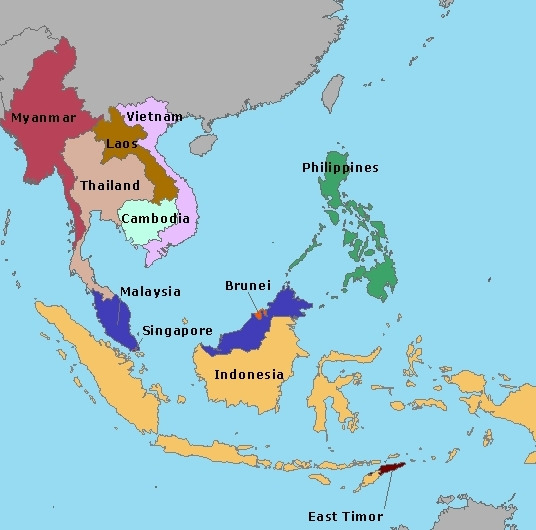
A. Southeast Asia
“All we have to decide is what to do with the time that is given us.” ― J.R.R. Tolkein
Southeast Asia is composed of eleven countries of impressive diversity in religion, culture and history: Brunei, Burma (Myanmar), Cambodia, Timor-Leste, Indonesia, Laos, Malaysia, the Philippines, Singapore, Thailand and Vietnam. Based on my research, the predominant themes of Southeast Asian arts have been religion and national history. In religion the main interest was not so much in actual doctrine but in the life and personality of the Buddha and the personalities and lives of the Hindu gods. In national history the interest was in the legendary heroes of the past, and this theme appeared only after the great empires had fallen and the memories of their glory and power remained. The Buddha image, which went through various stages of development, remained the favorite motif of sculpture and painting. The depiction of scenes from his previous lives in fresco and relief sculpture also had the purpose of teaching the Buddhist ethics to the people, as the Jatakas emphasized certain moral virtues of the Buddha in his previous lives; it also gave an opportunity to the artist to introduce local color by using, as background, scenes from his own contemporary time. The depiction of scenes from the Hindu epics also had the same purpose and gave the same opportunity to the artist. Many figures from the Buddhist and Hindu scriptures, such as gods and goddesses, heroes and princesses, hermits and magicians, demons and dragons, flying horses and winged maidens, became fused with similar native figures, and, gradually, folklore plots became merged in the general religious themes.

B. East Asia
“Only the very weak-minded refuse to be influenced by literature and poetry.” ― Cassandra Clare, Clockwork Angel
East Asia is the eastern region of Asia, which is defined in both geographical and ethno-cultural terms. The modern states of East Asia include China, Hong Kong, Japan, Macau, Mongolia, North Korea, South Korea, and Taiwan. According to my research, some of the themes in East Asia literature are Immortality, Unfaithfulness, Disrespect in the Society, Abused Marriages & Families, Religion, Traditional Practices, Traditional Beliefs and Social Class. Some of the books in East Asia were concerned of the ethical practices that were common in their society. Some of them are about “respect.” Respect is one of the most cherished virtues in the society, and many of the East Asian literatures have always expressed this in different ways, especially the need to respect the elderly and those in power. Another common theme that comes out of the books focuses on the abused marriages. In the two cases, we witness marriage partners engaging in abusive acts against their wives or husbands. There are so many books which possesses such styles and themes in literature.
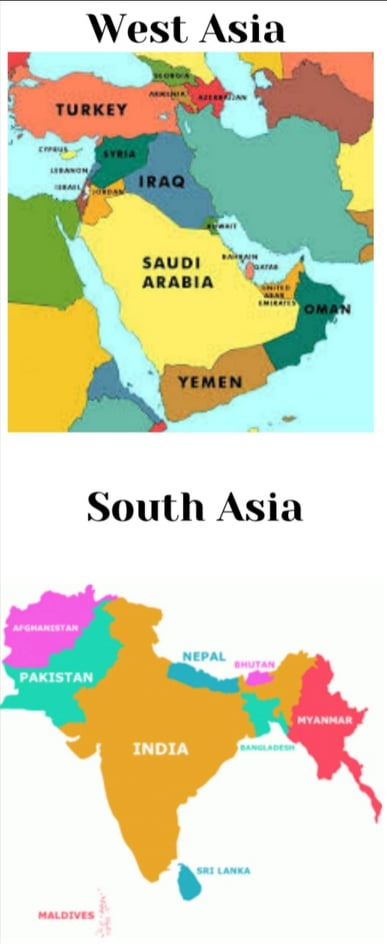
C. South and West Asia
“There is no surer foundation for a beautiful friendship than a mutual taste in literature.” ― P.G. Wodehouse
South Asia or Southern Asia is the southern region of Asia, which is defined in both geographical and ethno-cultural terms. The region consists of Afghanistan, Bangladesh, Bhutan, India, the Maldives, Nepal, Pakistan, and Sri Lanka. The West Asia region comprises of 12 member countries; Bahrain, Iraq, Jordan, Kuwait, Lebanon, Oman, State of Palestine, Qatar, Saudi Arabia, Syrian Arab Republic, United Arab Emirates and Yemen. Based on my research, the peoples of South Asia have had a continuous literature from the first appearance in the Punjab of a branch of the Indo-European-speaking peoples who also settled all of Europe and Iran. In India this branch of Indo-Aryans, as they are usually called, met earlier inhabitants with different languages and no doubt a different culture—possibly a culture akin to that of the Indus Valley civilization, which had a script, and perhaps a literature of its own, of which nothing is known. Certain to have been settled in India were peoples who spoke languages of Dravidian origin, as well as other languages, called Munda, now preserved only by aboriginal tribes, which show affinities with the languages of Southeast Asia. In the Hellenistic period literature and culture flourished in Western Asia. Traditional literary forms such as lists continued to be produced by the native population and were adapted by the new rulers. While there is little evidence for the creation of new narrative literature, which may in part be due to the fragmentary nature of our sources, existing epics, wisdom texts, and folktales were retold, rewritten, and transmitted. Greeks living in Western Asia created historiographical, ethnographical, and geographical works about their surroundings, inspiring in turn the Babylonian priest Berossus to write a reference work on Babylonia in Greek. Much as during the Persian Empire, political instability and changes in power led to a diverse and independent culture of writing. Continuity in all genres, writing systems, and languages remains the most important characteristic of Western Asian literature at least to the beginning of the Christian era.
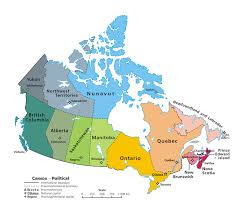
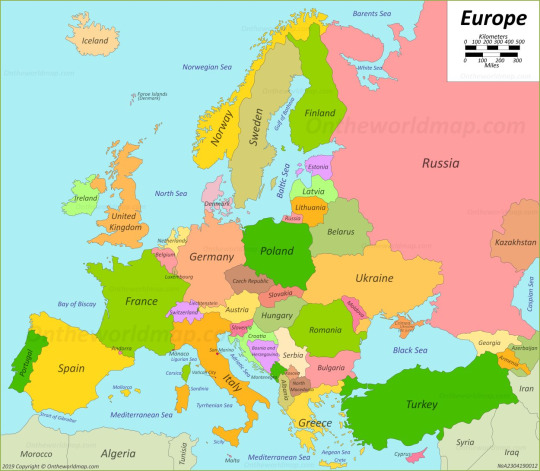
D. Anglo-America and Europe
“Literature is the most agreeable way of ignoring life.” ― Fernando Pessoa, The Book of Disquiet
Anglo-America most often refers to a region in the Americas in which English is a main language and British culture and the British Empire have had significant historical, ethnic, linguistic and cultural impact. Europe is a continent located entirely in the Northern Hemisphere and mostly in the Eastern Hemisphere. It comprises the westernmost part of Eurasia and is bordered by the Arctic Ocean to the north, the Atlantic Ocean to the west, the Mediterranean Sea to the south, and Asia to the east. Based on my research, like other national literatures, American literature was shaped by the history of the country that produced it. For almost a century and a half, America was merely a group of colonies scattered along the eastern seaboard of the North American continent—colonies from which a few hardy souls tentatively ventured westward. After a successful rebellion against the motherland, America became the United States, a nation. By the end of the 19th century this nation extended southward to the Gulf of Mexico, northward to the 49th parallel, and westward to the Pacific. By the end of the 19th century, too, it had taken its place among the powers of the world—its fortunes so interrelated with those of other nations that inevitably it became involved in two world wars and, following these conflicts, with the problems of Europe and East Asia. Meanwhile, the rise of science and industry, as well as changes in ways of thinking and feeling, wrought many modifications in people’s lives. All these factors in the development of the United States molded the literature of the country. Western European literature could be viewed as a parade of movements—Romanticism, Realism, Naturalism, Futurism, Structuralism, and so on indefinitely. European literature refers to the literature of Europe. European literature includes literature in many languages; among the most important of the modern written works are those in English, Spanish, French, Dutch, Polish, German, Italian, Modern Greek, Czech and Russian and works by the Scandinavians and Irish. Important classical and medieval traditions are those in Ancient Greek, Latin, Old Norse , Medieval French and the Italian Tuscan dialect of the renaissance. European literature, also known as Western literature, is the literature written in the context of Western culture in the languages of Europe, as several geographically or historically related languages. Diverse as they are, European literatures, like Indo-European languages, are parts of a common heritage belonging to a race of proud nations which boast the likes of Homer who wrote Iliad and Odyssey, Virgil who wrote the Aeneid, Dante who wrote Divine Comedy, Chaucer who wrote Canterbury Tales. These, and other literary masterpieces form part of what we call as Western Canon.

E. Africa
“Literature is a textually transmitted disease, normally contracted in childhood.” ― Jane Yolen
Africa is the world's second-largest and second-most populous continent, after Asia in both cases. At about 30.3 million km² including adjacent islands, it covers 6% of Earth's total surface area and 20% of its land area. With 1.3 billion people as of 2018, it accounts for about 16% of the world's human population. Based on my research about Africa’s Literature. Afro-Asiatic and African languages together with works written by Africans in European languages. Traditional written literature, which is limited to a smaller geographic area than is oral literature, is most characteristic of those sub-Saharan cultures that have participated in the cultures of the Mediterranean. In particular, there are written literatures in both Hausa and Arabic, created by the scholars of what is now northern Nigeria, and the Somali people have produced a traditional written literature. There are also works written in Geʿez (Ethiopic) and Amharic, two of the languages of Ethiopia, which is the one part of Africa where Christianity has been practiced long enough to be considered traditional. Works written in European languages date primarily from the 20th century onward. The literature of South Africa in English and Afrikaans is also covered in a separate article, South African literature.

F. Latin America
“Literature is news that stays news.” ― Ezra Pound
Latin America is a group of countries and dependencies in the Western Hemisphere where Romance languages such as Spanish, Portuguese, and French are predominantly spoken. According to my research about Latin America’s Literature. Romanticism, Realism, Naturalism, and Emerging Literary Trends. The Latin American wars of Independence that occurred in the early nineteenth century in Latin America led to literary themes of identity, resistance, and human rights. Latin American literature, the national literatures of the Spanish-speaking countries of the Western Hemisphere. Historically, it also includes the literary expression of the highly developed American Indian civilizations conquered by the Spaniards. Over the years, Latin American literature has developed a rich and complex diversity of themes, forms, creative idioms, and styles. A concise survey of its development is provided here. For a history of literature written in Portuguese in Brazil, see Brazilian literature. Latin American literature refers to written and oral works created by authors in parts of North America, South America, and the Caribbean. Latin American authors usually write in Spanish, Portuguese, English, or a language native to their specific country. Latin American writers working in the United States can be classified as writing Latin American literature too. Latin American literature has a rich history starting in the Pre-Colombian period and working all the way up to modern day. With each period of Latin American history, came a genre that dominated the field. In this lesson, we will look at the main periods of Latin American literature, the genres that fueled those periods, and authors who are well known in Latin American literature.
Source:
Wikipedia, Britannica, Google and Online Library.
Saunar, Rhenz Rhyanne
11 - St. Alypius
7 notes
·
View notes
Text
Whenever I discuss Sleeping Beauty with someone who doesn’t share my enthusiasm for Disney, they have an irksome tendency to get it muddled with Snow White; their excuse being “it has the same plot”. I’ll admit, there are some surface similarities that even the most casual viewer can pick up on: a fairytale where a princess is forced into unconsciousness and wakes up with some necking, the comic relief and villain being the most beloved characters, a little frolic in the forest with animals, the antagonist plunging off a cliff, you get the idea. In fact, Sleeping Beauty even reuses some discarded story beats from Snow White, mainly our couple dancing on a cloud and the villain capturing the prince to prevent him from waking his princess. Yet despite that, Snow White and Sleeping Beauty are two wholly different movies shaped by the era and talents of the time.
I’ve discussed how Walt Disney was never one to stick to a repeated formula, no matter how successful it was. He must have noticed the parallels between his first movie and this one, but decided to make one crucial change for Sleeping Beauty that would forever differentiate the two: the look. We all know the traditional Disney house style: round, soft shapes, big eyes; charming as it was and still is, Walt was sick of it after several decades. Meanwhile, artists like Mary Blair and Eyvind Earle were producing gorgeous concept art that rarely made a perfect translation into the Disney house style.
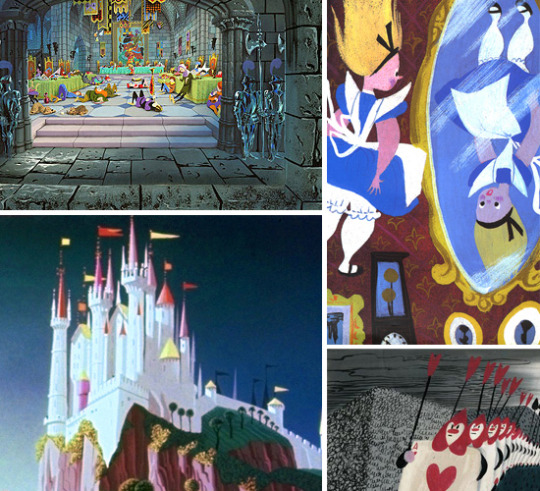
Walt wanted to make a feature that took the pop artistry of their designs and made the animation work for it instead of the other way around – which brings us to another animation studio that was doing well at the time, United Pictures Animation, or UPA.
UPA didn’t have the kind of budget Disney normally had for their animated projects, but what they lacked in fluidity they made up for in style. Watch The Tell-Tale Heart, Gerald McBoing-Boing and Rooty-Toot-Toot to see what I mean. UPA were pioneers of limited animation, taking their scant resources and creating some striking visuals with bold geometric designs. Through this, they defined the look of 50’s animation. Though perhaps unintentional, Sleeping Beauty comes across as Disney’s response to UPA, or what would happen if UPA had the funds they deserved. The characters’ contours are angular but effortlessly graceful, defining their inherent dignity and royalty. And the colors, ohhh the colors…
Because of the immense amount of work required to animate in this difficult new style (and in the Cinemascope ratio, no less) as well as story troubles and Walt barely supervising the animation studio now that he had his hands full with live-action films, television, and a theme park, Sleeping Beauty had a turbulent production that lasted the entirety of the 1950s. For a time, Chuck Jones of Looney Tunes fame was set to direct. Director Wilfred Jackson suffered a heart attack partway through production and Eric Larson, one of the Nine Old Men, took the mantle from there before Walt Disney replaced him Clyde Geronimi. And even after that, Wolfgang Reitherman teamed up with Geronimi as co-director to get the film finished after no less than three delays. Also, Don Bluth got his foot in the door as an assistant animator for this feature, beginning his short-lived but impactful tenure at Disney. Did all this hamper the movie, or did they succeed in what they set out to accomplish?
Well, one of the reasons why this review took so long was because I had a hard time not repeating “MOVIE PRETTY” and “MALEFICENT AWESOME” over and over. Make what you will of that.
The story begins as most fairy tales do with your typical king, Stefan, and his queen suddenly blessed with a baby girl after years of wishing for a child. They christen their daughter Aurora (middle name Borealis, localized entirely within their castle) and throw a huge celebration in her honor. People come from all over the kingdom to pay homage to the princess and OSMKFKSBFHFGILWBHBFC…
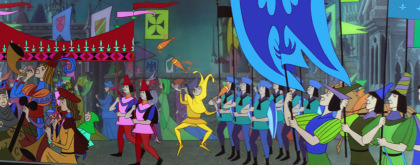
Movie pretty…
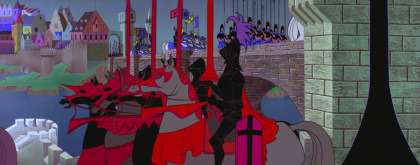
Movie pretty…
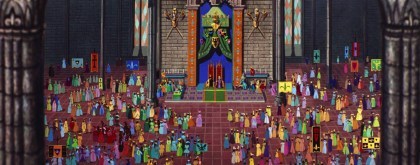
MOVIE PRETTIEEEEEE…
John Hench, Academy Award-winning special effects man and art director, turned Walt on to the idea of basing the look of Sleeping Beauty on classic medieval artwork. Thanks to him and Eyvind Earle’s insanely detailed designs and backgrounds, this is one of Disney’s most visually distinct and beautiful films. A single still from this feature wouldn’t feel out of place up in The Cloisters.
Among the party guests is King Stefan’s old friend King Hubert (Bill Thompson) bringing his young son Prince Philip. Stefan and Hubert wish to unite their two kingdoms and formally announce Philip’s betrothal to the infant Aurora.

“We were going to do it during the second trimester, but we decided to wait until she was more mature.”
By the way, your eyes are not deceiving you. That is Aurora’s mother, Queen Leah, alive and well and named. And frabjous day calloo callay, she even gets some lines! The most common joke about Disney princesses is that they don’t have moms (even Ralph Breaks The Internet went out of its way to highlight that), so as a hardcore Disney fan who often has to put up with this generalization, Leah’s existence leaves me feeling vindicated.
Once that happy revelation is out of the way, we’re introduced to our main protagonists.
Oh, you thought I was referring to Philip and Aurora? Nonononono, my friends. THESE are the true heroes of Sleeping Beauty, the Three Good Fairies.

The fairies started off as one-note side characters sharing the same personality. Think pre-Ducktales-reboot Huey, Dewey, and Louie in dresses. But the studio had a difficult time giving Aurora more depth and was having a lot more fun developing the fairies. Naturally, they became so fascinating and appealing that more screentime was given over to them. Now the story’s carried by three wonderfully fleshed out ladies who are distinct in both looks and personality: Flora’s the pragmatic tradition-adhering leader, Fauna’s the sweet scatterbrain who mediates, and Merryweather’s the feisty young upstart.
With the plot now focused on characters who held a traditionally minor role, it’s easy to read this as a perspective-flipped version of the fairytale, but there’s more to it than that. Remember in my Clash of the Titans review how I mentioned the gods literally play chess using the heroes as pieces? I tend to view the main conflict of Sleeping Beauty in the same way. The Three Fairies and Maleficent are in a constant game of good vs. evil, moving Aurora, Philip, and the rest of the royals as pawns in their plans. There’s plenty of plotting and intrigue, with both sides constantly guessing and second-guessing the other’s next maneuver, and even if you’re already familiar with the story’s trajectory you’re still left on the edge of your seat as it inches towards the fiery climax.
And dare I say it but…the fairies and their power dynamic make this Disney’s most feminist film. Yes, really. You could argue that some of the other animated movies from the Renaissance and Revival period have more notable, stronger female protagonists, and many of the live-action remakes try to be woke without really grasping the concept, but consider this: The cast of Sleeping Beauty is mostly female, the leads aren’t objectified in any manner (that is if you count Aurora as a supporting character), nor does their gender factor into their competency, each one differs in age and body type, and most of them are working together towards a common goal as opposed to against each other. Name a movie in the past decade that does the same and still manages to be entertaining (no, really, I’d love to see it). There’s even one scene that unintentionally provides great commentary on the divides in the feminist movement, but more on that later.
Flora and Fauna bless the baby with beauty and song respectively which are accompanied by a short chorus and some sumptuous graphics. I don��t think I need to reiterate that when this movie goes extra with the visuals, it GOES EXTRA with the visuals. Next comes Merryweather with her gift. To this day, no one knows what Merryweather intended to give Aurora. Flora’s the most traditionally feminine of the three so her giving Aurora beauty comes as no surprise. By comparison, Merryweather is the most forward (or unconventional, depending on your point of view). I wouldn’t put it past her to favor Aurora with intelligence, or humor, or passion, or creativity or humility or confidence or decisiveness or physical fitness or great swordsmanship or telekinesis or ice powers or one million YouTube subscribers or comfort in her female sexuality.
Me personally, I think I’ve got the best gift of all:
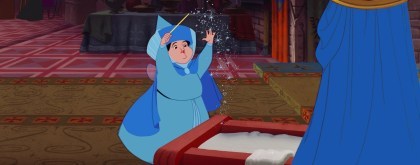
“O Princess, my gift shall be…getting all reviews posted on time for once!”
Alas, before Merryweather can bestow such a wondrous quality upon the child, she’s interrupted by a horny party crasher.
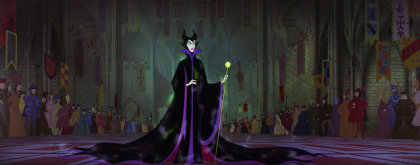
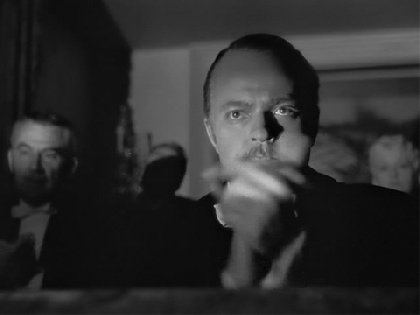
Maleficent. The Mistress of All Evil. Chernabog’s right-hand witch. The Disney villain all Disney villains strive to be. She has it all – the looks, the poise, the power, the laugh, the cunning, the ruthlessness! She doesn’t even need to sing a song because she’s already awesome enough without one. Marc Davis’ gothic design cuts a fine figure and Eleanor Audley’s subtle icy voicework is trés magnifique. As much as I enjoy Audley as Cinderella’s evil stepmother, Lady Tremaine was but an appetizer in comparison to the four-course banquet of pure villainy that is Maleficent.
This leads to a small point of contention some viewers have with Maleficent in spite of hitting top marks elsewhere: her motivation. Putting a hit out on a child for not getting invited to a measly party? Not exactly compelling, is it? And yes, it isn’t a deep motive…is what I would say if I wasn’t well-versed in folkloric tradition. In the original fairy tale and the movie (though it isn’t outright stated in the latter), the party for Aurora isn’t just your average royal kegger, it’s a christening. Back in ye olden days, christenings were very big deals. To not receive an invitation to one was a grave insult, so not extending an invite to your semi-omnipotent magical neighbor is just asking for trouble. In the fairy tale’s defense, no one had seen the evil fairy for years and assumed she was dead, though I can’t imagine how nobody thought Maleficent wouldn’t find about it eventually.

“You dare to deny me, foolish mortals? Very well, then! I shall have my own christening! With blackjack! And strumpets!”
Maleficent is proof that sometimes you don’t have to have an elaborate backstory, a god complex, a tragic past or the unfortunate luck to be on the wrong side of a conflict. Sometimes all you need is some magic, brains, class, and a whole lot of flair to be a perfect, intimidating, and unquestionably iconic villain.
Basically what I’m saying is these movies never happened. Got it?
Maleficent is disarmingly polite over being snubbed, even after Merryweather bluntly tells her nobody wanted her to come. She even brought her own gift for the baby – sixteen years of life cut short by the prick of a spinning wheel spindle, because why change into a dragon and destroy everyone all at once when you can draw the torture out over an agonizingly long time and deliver the coup de grace in the prime of a young woman’s life? That’s how Maleficent rolls, baby. She could dole out capital punishment when she has to without batting an eyelid, but causing human suffering is her bread and butter.
Stefan begs the fairies to undo Maleficent’s curse, but it’s too strong for them. Flora and Fauna insist, however, that Merryweather can use her gift to lessen the spell’s potency. Now instead of dying from that fatal prick, Aurora will sleep until she receives True Love’s Kiss™. Stefan’s not one to throw caution to the wind though, so he orders all of the kingdom’s spinning wheels to be burned in the meantime.

I just pray his kingdom’s economy wasn’t based on textiles otherwise they’re screwed.
As the peasantry celebrates Guy Fawkes Day several centuries early, the fairies ponder their next move. They’ve been around long enough to know that removing spinning wheels from the equation won’t put a damper on Maleficent’s scheme. This scene is incredibly effective in establishing two things:
Maleficent’s near-omniscient presence in the film
How well the fairies’ differing personalities play off each other
Maleficent rarely miscalculates her opponents, and that guile puts her one step ahead of the heroes, making her one of the few Disney villains to nearly reach their goal. The only mistake she makes in the entire movie is trusting her henchmen to do their jobs when she isn’t directly supervising them, though that’s more on them than her. The different methods the fairies propose to deal with Maleficent fantastically illustrate what kind of people they are. Fauna believes she’s just a miserable soul who could be reasoned with if they talk things over. Merryweather would rather take the fight to Maleficent and turn her into a toad. Flora, however, is wise enough to know Maleficent’s too wicked to plead to, too clever to bargain with and too strong to face head-on, so their best course of action is to focus on protecting Aurora through any means necessary. Her initial idea is to enchant the princess into a flower (her namesake is her specialty, after all), but Merryweather reminds her that Maleficent enjoys creating bitter frosts just to kill her flowers.
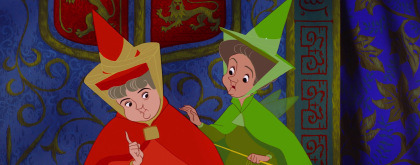
“Well we could try that but stick her in a castle with a beast for a while…nah, that’ll never work.”
Yet never one to give up, Flora alters the plan so they’ll raise Aurora as a peasant girl out in the woods. This means disguising themselves as humans and giving up magic for sixteen years so as to not attract Maleficent, but that amount of time is like twenty minutes to the fair folk. Stefan and Leah reluctantly agree to the plan, and the fairies spirit little Aurora away from the castle that very night.
Sixteen years later, Maleficent is infuriated that her minions have failed to locate Aurora, even more so when one reveals that they’ve spent the whole time looking for a baby instead of a maturing woman. In an interview with the Rotoscopers podcast, Don Bluth called Maleficent a very flat antagonist because she surrounds lackeys dumber than her so she could be the smart one among them and, again, her supposed lack of motivation. But come on, let’s not entirely condemn the bad guys for having too much faith in their underlings. It’s difficult to find minions smart enough to carry out orders but dumb enough to stay unquestioningly loyal. Usually you have to register as Republican in order to get some.
Maleficent gets her anger out in the most therapeutic way – throwing lightning bolts at her orcs, awesome – then leaves the job of finding Aurora up to her trusty raven Diablo. We then finally see the grown-up Aurora herself, whom the fairies renamed Briar Rose as a nod to the Brothers Grimm version of this tale.
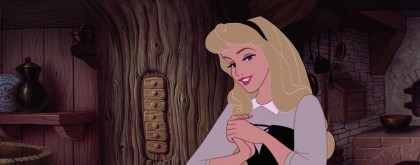
I know I’ve made the occasional case for the princesses from Walt’s era compared to the present day, and yet I have a hard time defending how…I don’t want to say bland. Bland would mean there’s nothing interesting about Aurora, and that’s a lie. She’s gorgeously designed and drawn, and even in her peasant dress she has an air of elegance and sophistication. She carries herself like a queen; her innate royalty reveals itself in her graceful movements. Mary Costa also gifts her with an excellent set of pipes. Hearing her song echoing through the forest is nothing short of magical. She’s a flower child who can talk to animals. She has dreams of escaping her adopted aunts’ loving but stifling care and being allowed to grow up, see the world, actually talk to people, and even find a life partner. She has some strong potential. It’s not that Aurora’s boring, she’s just not quite as developed as we’ve come to expect our animated female protagonists to be. I’m grateful for what we’ve got, but I only wish we could have more. What was her childhood like? How did she learn to communicate with animals? When did the fairies trust her enough to let her spend time out on her own? Did the fairies ever subtly teach her lessons in royalty through lessons and games? Heck, nobody bothers to keep her informed about Maleficent or her curse, and they act surprised when she’s shocked to learn she was a princess the whole time. I want to see what Aurora could have been like if she had known the truth already and what kind of steps she would take to defend herself. Blame the source material for this; it’s difficult to write a compelling main character when she’s supposed to sleep through most of her story.
The fairies send Aurora on a fetch quest so they can plan a surprise birthday party for her. Merryweather wants to bring their magic wands back out for the job, but Flora insists on taking no chances now that they’re in the home stretch. Fauna gets to live her dream of baking an elaborate cake (it’s thanks to her referring to a teaspoon as a “tsp” that I do it too), and Flora insists on making Aurora a gown fit for a princess using Merryweather as a dummy. And we also get one of the best burns in the Disney canon:
Merryweather: It looks awful!
Flora: That’s because it’s on you, dear.
youtube
The fairies fall into reminiscing over raising Aurora and get teary over having to let her go soon. I see where they’re coming from, they’re the ones who raised her for sixteen years. They must have so many fond memories, not to mention they put all that work into learning to properly raise a child let alone live like normal human beings seeing how two of them still can’t sew or cook without magic. I wonder what that was like –
No, NO, you CGI abominations DO NOT exist! Go back to the fires from whence you came!!
“Ugh, I’m gonna need something strong to expunge that from my eyes.”
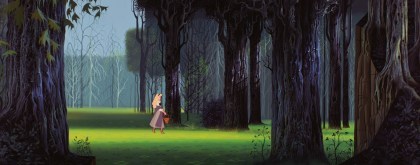
There we go.
Aurora wanders through the forest, drawing out the usual bevy of cute woodland critters with her singing. She also catches the attention of a grown-up Prince Philip (Billy Shirley) who’s more dashing and considerably less blonde than he was sixteen years ago.
By this point, the Disney animators were far more confident in their ability to draw realistic but expressive leading men, hence Philip’s expanded role from the story. He’s also the first Disney prince to have a personality; not a terribly deep or defined one, but it’s a step up from his nameless plot-device predecessors. There are some signs of him being a hopeless romantic, he gets a few funny lines here and there, has a sturdy friendship with his horse Samson, and is fiercely determined when it’s time to kick some ass. He does have the same problem as Aurora in he randomly decides to stop talking for the rest of the movie once he reaches the midway mark (at least Aurora has the excuse that she’s sleeping for that remainder), but I suppose you could chalk this up as to him wanting to spite Maleficent with his silence.
The animals steal some of Philip’s clothes so they can pretend to be Aurora’s dream prince. Aurora plays along as she sings the movie’s standout song, “Once Upon a Dream”. Philip and Samson watch until he smooths his way into the dance. Once Aurora discovers the switch, Philip gets a little too up in her personal space for my liking, constantly grabbing her hand so she doesn’t run off and pulling her closer to him. Not as horrible as what the prince does to the sleeping princess in the original story (a questionably consensual kiss is a trifle compared to how the scumbag of a prince treats her there), but still a bit iffy.
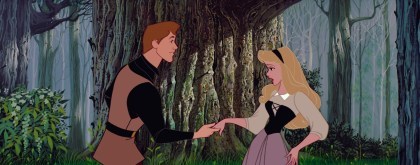
“It’s a good thing my aunts taught me to never go anywhere without a loaded pistol taped to my back.”
But once Philip backs off a little and joins in her song, they both dance together and OEHSGBJSGBLL…

I think I’m going to need surgery to get my jaw off the floor back into its proper place thanks to this movie.
As per Disney tradition, Aurora and Philip’s waltz means the two are head over heels in love with each other. But when it comes time to finally exchange names, Aurora panics and runs away, though she sticks around long enough to tell Philip to meet her family at the cottage that evening.
Back at home, the party preparations aren’t proceeding as planned. Flora’s dress looks as good as my attempts at dressmaking, and Fauna’s dessert wouldn’t feel out of place on Cake Wrecks.
A fed-up Merryweather reads Flora and Fauna the riot act and convinces them to finally take up their wands again. This produces more desirable results, though Merryweather still gets stuck with cleanup duty.
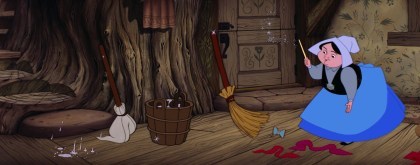
Enchanting a broom to come to life and do your dirty work? I don’t see this going wrong in any possible way.
Things start to go south when Flora and Merryweather argue over the dress color and it escalates into a full-blown wizard’s duel. This gag was supposedly based on the animators’ arguments over what was Aurora’s proper dress color. I think they should have compromised and combined both colors to make purple, which would go lovely with Aurora’s violet eyes, but what do I know. I’m just the illustration major writing a blog. Unfortunately, while the fairies remembered to cover every door, window, and crack that could expose their magic, they overlooked the fireplace. The sparkly residue of Flora and Merryweather’s fight fly up the chimney, alerting Diablo to their hideaway.
Going back to what I said earlier about this movie providing some commentary on feminism, consider this: Flora is obsessed with pink, a traditionally female color, and she gives Aurora an attribute that is oft preferred in a woman but not the most important quality, beauty. Merryweather, on the other hand, is all about blue, a color usually geared towards boys, and she has much more common sense and practicality about her. Though Merryweather and Flora are able to put aside their differences in personalities and approaches for a common goal, it’s when they refuse to compromise and begin prioritizing which color – ie. which ideology and extension of themselves – that they want Aurora to step into that they lose sight of what’s important, and allow everything they worked for to collapse on itself. It’s played for laughs very well, sure, but if not’s symbolic of the dichotomy between traditional femininity and modern sensibility that tears apart the feminist movement then I don’t know what is.
The fairies manage to fix their messes in time for Aurora’s return. She’s thrilled with their gifts but shocks them all when she announces her new boyfriend is coming over for dinner. They come clean about her heritage and betrothal to Prince Philip, and Aurora runs up to her room in tears over the fact that she’ll never see her one true love again. That and her entire life has been a lie and she’s being carted off to meet parents she knows nothing about to marry a man she’s never met and rule an entire kingdom with no prior experience or knowledge. But mostly the true love thing.
Meanwhile, Stefan and Hubert are making wedding plans over wine with “Skumps”, the preferred toast between me and my friends. Also adding to the humor is a minstrel who keeps stealing sips until he literally drinks himself under the table.
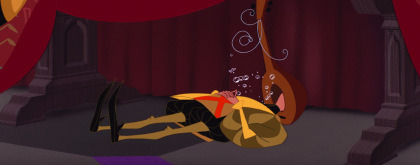
This was also his way of getting through the Black Plague, co-opted by the rest of the world six hundred years later.
Philip returns and Hubert goes to greet him. He thinks his son is thrilled at the prospect of marrying Aurora but is disappointed to learn that he’s fallen for an anonymous peasant.
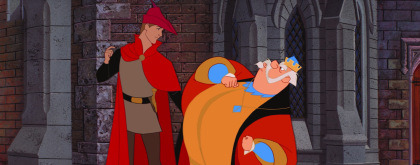
“At least tell me if she’s royalty in disguise so you don’t elope to Sicily!”
Philip rides back into the woods for his big date, leaving Hubert with the unenviable task of breaking the bad news to Stefan. As for Aurora, the fairies smuggle her into the castle and prep her for her homecoming. She’s still blue over having to ghost her forest hubby though, so the fairies give her some time to herself.
Biiiiiiiiig mistake.
So imagine you’re me, growing up watching this movie on tape on a television set with a very standard but not spectacular sound system. Then years later you download the remastered soundtrack and give it a listen while you’re falling asleep. You’ve got the whole score memorized, the volume is nice and low, it’s all good.
And then, just as you’re drifting off, you hear a ghostly voice singing in your ear “Auroraaa…Auroraaaaa…”

That reminds me, I haven’t had a chance to talk about the music yet, haven’t I? Forgive me for waiting so long to do so but my reaction to it is equivalent to the visuals. The score is taken straight from the Sleeping Beauty ballet by Tchaikovsky, the same composer as The Nutcracker, and it is lush, sweeping, sumptuous, just…

While George Bruns was mostly faithful with how the score was represented within the context of the ballet, at certain points he took the same approach as The Nutcracker Prince and rearranged the music order to underscore totally different scenes to staggering effect. The beautifully ominous music where Maleficent appears as a ball of green flame and leads the hypnotized Aurora to her doom? It’s from one of the ballet’s divertissements where Puss in Boots dances with his girlfriend. But tell me which is more fitting for a musical composition such as this – two cats pirouetting around each other in a crowded ballroom, or eerie pitch-black spiral staircases illuminated by green fire as a cursed princess inches closer to her dark destiny against her will?
youtube
The fairies realize their error and frantically search the maze of secret passages for Aurora. Though the princess resists Maleficent’s commands for only a moment, they are still too late to save her from fulfilling the curse. Maleficent gloats and leaves the fairies to wallow in their failure. It’s made even worse as the merrymaking from the oblivious revelers below ring out while they put Aurora to bed in a tower and mourn over her. It’s heartbreaking: they raised and loved her as if she were their own daughter, and they still couldn’t protect her. Everyone talks about “Baby Mine” and Bambi’s mom as huge tearjerkers, but why is this scene constantly forgotten?
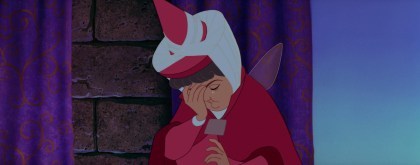
Stupid onions, stupid stupid onions…
Fauna and Merryweather can’t even begin to imagine how heartbroken Stefan and Leah will be, but Flora has a solution: put the kingdom to sleep along with Aurora until she is woken up. I understand her wanting to spare Aurora’s family some pain, but conking out an entire principality for god knows how long to cover up their failure? AND at a time when Europe was all about invading and conquering itself? Are we sure this isn’t just part of Maleficent’s overarching plan for revenge? This sounds more like something she would come up with instead of the leader of the good guys.
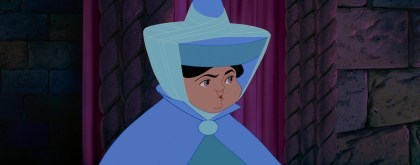
“So what happens if one of the neighboring kingdoms decides to attack while everyone’s sleeping?”
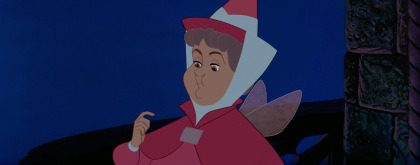
“Then we’ll put them and their armies to sleep, too.”

“And once Aurora is saved, both kingdoms will immediately wake up to find themselves thrust into a war they’re barely prepared for, is that correct?”

“Oh, you’re right, that’s a terrible idea.”

“Finally, thank you.”

“I’ll just turn them all into flowers.”

“THAT’S NOT AN OPTION!!!”
The fairies flitter about the castle grounds spreading their spell over the unwitting royal court, even putting the candles and sconces out. We have another reprise of the “Gifts of Beauty and Song” chorus now altered to sound like a lullaby, providing an interesting bit of symmetry between it and its earlier use in the film. Whereas it first underscored their blessings upon Aurora, now it plays as the fairies are giving the “gift” of sleep to the entire castle.
While Flora knocks out the throne room, she overhears Hubert muttering about Philip eloping with a peasant girl and she makes the connection. The fairies speed to the cottage just as Philip arrives there. But once again Maleficent beats them to the punch. Her goons ambush Philip and she watches them wrestle and bond him with fiendish glee.

You magnificent, kinky bitch.
Maleficent was only out to capture the one man who could break Aurora’s curse; the fact that he’s really the son of her nemesis’ allies is just icing on the cake. Flora, Fauna, and Merryweather resolve to rescue him from Maleficent’s fortress in the Forbidden Mountain.
Some movies reach the brink of greatness only to falter when it comes to the final act. Sleeping Beauty is not one of them. Everything that happens from the moment we slowly zoom in through the purple mist on to the Forbidden Mountain itself up until the storybook closes is perfection. The perfectly paced action, the animation, the music, Maleficent’s hideaway in all its decaying glory (I swear it’s like Jean Cocteau meets Frank Frazetta meets Giotto) all make for the climax of climaxes.
The fairies shrink to insect size and silently sneak through Maleficent’s creepy domain, narrowly running into guards and gargoyles at every turn. They traverse the stronghold until they find her overseeing a hellish bacchanalia in honor of her supposed victory.
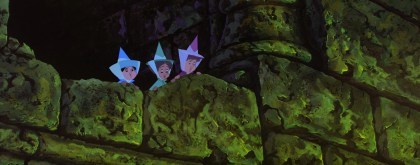
“My old gaffer would have a thing or two to say if he could see us now.”
Soon Maleficent gets bored and goes to “cheer up” her captive. Then we have it: The Moment.
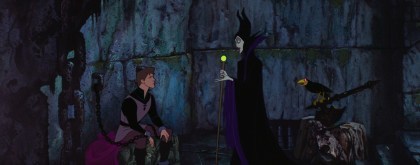
I’ve talked about this before, that one small, devious step further the villain takes to make themselves more heinous in our eyes. It’s the Wicked Witch taunting Dorothy with visions of Aunt Em. It’s the Beldam hanging Other Wybie’s remains. It’s virtually everything Heath Ledger’s Joker does. And it is this simple scene where Maleficent details what she plans to do with Philip. She spins “a charming fairy tale come true” of Aurora sleeping without aging, waiting for her prince to come to wake her. And Philip will escape the dungeon, ride to her rescue and prove true love conquers all – in one hundred years, when he’s a broken old husk of a man on the brink of death. DAMN. If you want to know why Maleficent is considered the best of all the Disney villains, it’s not just all her previously praised qualities, it’s her sheer sadism and the pleasure she takes in it.
The fairies enter and free Philip once Maleficent departs. The course of true love never runs smoothly though, so they arm him with the Shield of Virtue (licensed by Carefree Maxi-Pads), and the Sword of Truth to aid in his escape.
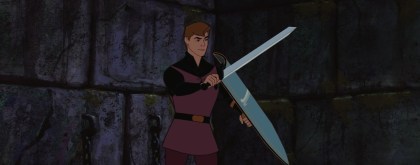
“So, why’s it called the Sword of Truth?”
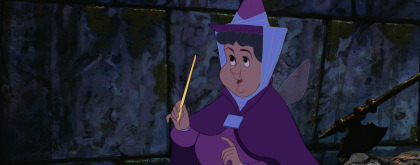
“Anyone who’s subjected to it speaks only the truth…as they bleed out and die, of course.”

“Cool, cool. On an unrelated note, I think I’m gonna go to DC for my honeymoon.”
Diablo sounds the alarm and the Battle With the Forces of Evil kicks off with Philip slashing his Sword of Truth through Maleficent’s goons.
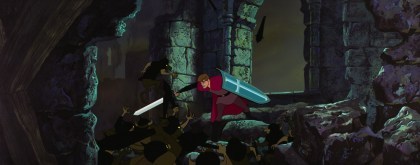
“I steal lunches from the break room fridge!” “I broke wind last Tuesday and blamed it on the dog!” “I cried like a little girl during The Good Place finale!” “I only wash my hands for NINETEEN seconds at a time!”
Philip makes his getaway on Samson and the music reaches truly operatic levels as Maleficent does everything in her power to end him. Yet Philip soldiers through it like a boss. Crumbling mountainsides, Maleficent hurling lightning from the sky and summoning a forest of thorns to block the way? Fuck that shit, he’s gotta go save his girl.
Then, as Philip cuts his way through the briars, Maleficent looks at her watch, realizes it’s No More Fucking Around O’Clock, zooms over to the castle, throws down the most intimidating challenge ever –

“Now you shall deal with me, O Prince, and all the powers of HELL!!”
– and with that, she takes her final form: a massive fire-breathing dragon.
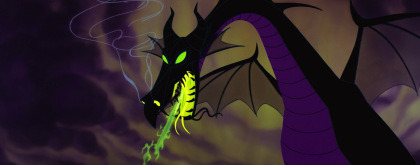

Every Disney villain who’s gone kaiju in the final act owes everything to this gorgeous terrifying beast. The dragon is an awe-inspiring unholy fusion of style, power and darkness. There’s a reason why she’s the final boss in Fantasmic; the chance to watch a live dragon battle is too cool to pass up.
Speaking of battles, Maleficent’s dragon form was animated by Woolie Reitherman, who previously brought us such gargantuan monster clashes as the T-rex brawl in Fantasia and the escape from Monstro The Whale in Pinocchio. And when you have a dragon confronting a fairytale prince, well, you know what’s coming.

Maleficent backs Philip on to a cliff surrounded by flames, leaving him only one desperate shot. With a little extra magic from the fairies, he throws his Sword of Truth at Maleficent and it plunges right into her heart.
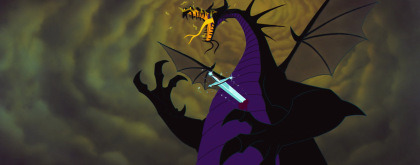
“I liked…Frozen 2…more than the first one…”
Maleficent’s spells die with her, clearing the way for Philip. He gives Aurora that wake-up smooch and everyone in the castle slowly rouses, owing their inexplicable simultaneous twenty-minute blackout to the unusually strong wine.
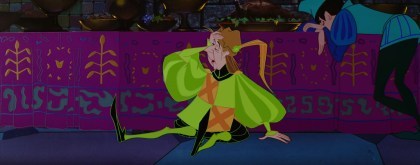
He can attest to that fact.
The royal families are happily reunited, and the film ends on Flora and Merryweather fighting over Aurora’s dress color yet again as she and Philip waltz together on the clouds using animation Beauty and the Beast would borrow thirty-two years later.
Sleeping Beauty is a movie I can never have on in the background because the moment I look up from my work I am spellbound by it. Do I need to elaborate on how this is one of the most beautiful looking and sounding movies Disney’s ever produced? Sleeping Beauty is the swan song of Disney’s first golden age of animation. For better or for worse, their animation process would switch to the rough, cost-cutting Xerox process starting with their next feature, 101 Dalmatians, and few films would reach Sleeping Beauty’s level of gorgeousness ever since.
Though a massive financial and critical hit on release, it wasn’t enough to make up for the monstrous production costs, not unlike Fantasia. Thankfully, home video sales revived interest and made it Sleeping Beauty of the top-selling VHS tapes of the decade, cementing it as a bonafide classic. It’s one of my favorites from Disney for its stunning visuals, gorgeous music, phenomenal villain and overlooked but great cast characters. Revisit it if you haven’t already.
Thank you for reading! If you enjoyed this review, please consider supporting this misfit on Patreon. Patreon supporters receive great perks such as extra votes for movie reviews, movie requests, early sneak-peeks and more! Special thanks to Amelia Jones, Gordhan Rajani and Sam Minden for their contributions!
Artwork by Charles Moss.
Screencaps from animationscreencaps.com
March Review: Sleeping Beauty (1959) Whenever I discuss Sleeping Beauty with someone who doesn't share my enthusiasm for Disney, they have an irksome tendency to get it muddled with Snow White; their excuse being "it has the same plot".
#2D animation#angelina jolie#animated#animated feature#animated movie#animated movie review#animated musical#animation#animator#animators#anthropomorphic animal#aurora#ballet#barbara luddy#battle#battle to end all battles#battle with the forces of evil#bill shirley#bill thompson#blue#briar rose#cake#charles perrault#classic disney#curse#diablo#Disney#disney animated#disney animated feature#disney animated movie
29 notes
·
View notes
Text
Disney+ What To Watch: My Top 10 Favourite Modern-Day Disney Classics
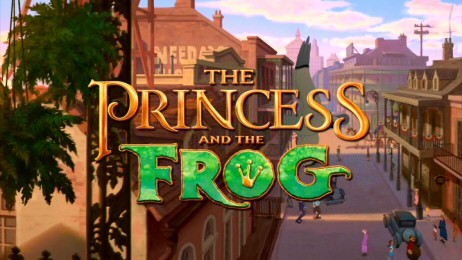
#2. The Princess and the Frog
With the Post-Renaissance era having mixed results from audiences, Disney decided to go back to its beloved an fruitful Disney Princess formula with the last 2D animated studio to date from the House of Mouse.
This not only reminded fans what they loved about Disney when it was on the top of its game, but also began what is now known as the Disney Revival era seeing a resurgence in Disney classics and it all began with the Disnefied spin on yet another classic fairy tale.
The Princess and the Frog does not get enough credit, period. Not only could this movie be mistaken for part of the 90s Renaissance, but the characters are fantastic, the comedy is on point, the music is original and fitting for the setting and...it may just be because there was a 71⁄2 year lull of sub-par movies from the mainstream Mouse House between Lilo & Stitch and this...but there is just this feeling of coming home or seeing an old friend again that I always get whenever I see this movie.
Now a lot of people who criticise this movie say that the main problem is the fact the plot seems very crowded, but really it is straight forward to follow and. if you treat it like a chessboard, the game is set up in the opening scene and song.
So basically you have, arguably, the best female Disney character in animation who has been brought up on strong moral values, she also has a life-long dream from a young age of becoming a well-known chef and owning her own restaurant to honour her father.
Simultaneously, you have a foreign spoiled prince who has been made broke by his parents who comes into the company of the movie’s villain who allows him to escape his troubles but by doing so curses him as a frog and employs his butler to take on the appearance of the prince, trick the local sugar baron’’s into marrying him and thereby takeover New Orleans and harvest its citizens for their souls to appease his friends on the other side.
Plots collide when our heroine meets the frog prince and is tricked into kissing him because he believes she is a princess and so promises to grant her the money for her restaurant if she frees him from his froggy prison, but instead she is turned into a frog and they must find a way to reverse the curse and thwart the evil villain.
I have genuinely just given a general synopsis of the movie in three very short paragraphs so if anyone still thinks this movie is confusing then either I’m missing something or you’re overthinking.
The lessons in this movie are so well learned and played out, the relationships are genuinely built up so that when our main protagonists do eventually fall in love it feels earned rather than just a business arrangement as it was originally going to be.
The choice to make this a 1912 Louisiana set movie, complete with a strong African-American protagonist and an equally strong ethnic Eurasian deuteragonist, as well as a Haitian villain, is genuinely revolutionary for not just Disney but family entertainment.
It doesn’t really shy away from prejudice, albeit while it is not a main focus of the movie, Tiana is put down numerous times not just for being a woman trying to succeed in life but also referred to as a woman with “her background” which means he skin colour, or her upbringing in a poor neighbourhood.
Tiana is the every girl for me, not only has she worked for everything that she has earned, even throughout the movie, but she has a smart head on her shoulders. She knows how to whip Naveen and her friends into shape, but also she is not afraid to stand up to the Shadow Man or any of her oppressors.
She also doesn’t believe herself a princess, she is not the type of doe-eyed dreamer that would usually fill the princess role. She has a drive, she’s determined, and it’s all real-world issues. Her motivations aren’t because of a man but providing for her future and maybe supporting her mother.
Even when cursed as a frog, she is still determined to achieve her goal, she just needs to be able to turn back into a human first which is where she learns life isn’t all about the endgame. That’s when she allows herself to open up to seeing the good in Naveen and allows herself to fall for him but in a natural organic way.
Anika Noni Rose does an absolutely amazing job as Tiana, she was born to be this character, I can genuinely see her as the live-action version of the character. Anyone saying Tiana was originally supposed to be Caucasian really needs a reality check, look at her design.
It also doesn’t hurt that Tiana’s main princess dress is green which happens to be my favourite colour.
Naveen is a lot like Flynn Ryder in terms of being that loveable rogue type of character but what elevates Naveen is he does at least learn and show personal growth throughout the movie, first with actually doing some hard work and cooking and then with developing actual emotions for Tiana and being conflicted into whether or not the most important thing is regaining his humanity and money or being with Tiana.
Dr. Facilier is one of the great Disney Villains, I may not be Haitian but I actually dressed as him for Halloween last year complete with UV skull face paint, now yes I’m practically a milk bottle and so a white skull face on me does not exactly show properly but I still felt very good about myself.
I loved the addition of voodoo to a family friendly atmosphere, it didn’t need to go into the blood rituals as heavily as say American Horror Story: Coven did but it still showed that a large part of voodoo is blood rituals with requiring Naveen’s blood in order to maintain the illusion of Lawrence being Naveen.
The personality they gave Facilier as well wasn’t exactly as sinister as Maleficent but instead more like Jafar or Scar, he allows himself to have his own brand of humour such as when he’s giving his tarot readings but also his sinister side manifests in how he utilises his magic and his friends on the other side and particularly his shadow.
Charlotte Le Bouff is probably the funniest supporting character I’ve seen since Mole from Atlantis or even the Genie in Aladdin. I absolutely love seeing this girl every time she is on screen, she steals the show in every scene she’s in. But also, you do feel for her. She wants that dream fairy tale life and you want her to get it because she is just that loveable.
If I had to say who I liked the least it would probably be Louis and Ray, nothing personally against them they are both decent comedic side characters, but they just seemed to be tagalongs and didn’t really contribute a purpose. Louis is an alligator who dreams of being a jazz musician which comes true when Tiana opens her restaurant and he is part of the house band, Ray is a Cajun firefly who is in love with a star and he gets to join her by becoming a star when he is, rather brutally, murdered by Facilier after a rather emotionally manipulating funeral scene.
Mama Odie and Eudora (Tiana’s mum) are great examples of Disney utilising named talent for minor roles, as both Jenifer Lewis and Oprah Winfrey respectfully do very reasonable jobs with what they’re given. I mean it’s Jenifer Lewis as a Voodoo Queen it’s just magic.
Just like Naveen, I was so happy with the infusion of Jazz music in this movie. I want to go New Orleans so badly, and I partially want to go there because it is the hub of jazz music. I loved the “Down in New Orleans” book-ended renditions at the start and the end of the movie, originally performed by Dr. John and in the reprise performed by Anika herself belting it out.
“Almost There” I love as a “I Want” song and as an empowerment mantra, it’s a song about focusing on your goals, working hard for them and it is catchy as hell.
“Friends on the Other Side” is the best villain song since “Be Prepared” and “Hellfire”. Not only does it give an amazing display of Facilier’s voodoo powers but Keith David delivers a fantastic performance all round.
“Dig a Little Deeper” is another great life motivation song, and if it is Jenifer Lewis singing it then she stays in character and does a great job.
The other songs are good, they’re nice but I do feel they’re a tad forgettable.
The Princess and the Frog is one of the more underrated Disney animated movies, it was unfairly weak at the box office, yet delivers a brilliant well-rounded story with fantastic characters, stunning visuals, great life lessons and an overall heartwarming feeling.
It’s also made me want to try beignets as I have never had them before.
So what do you guys think? Post your comments and check out more Disney+ What to Watch Top 10s as well as more Top 10 Lists and other posts.
#disney#disney+#disney plus#the princess and the frog#princess and the frog#disney+ what to watch top 10s#disney+ what to watch#my top 10 favourite modern day disney animated movies#my top 10 favourite modern day disney classics
18 notes
·
View notes
Text
Reverse Harem Anime Recommendations
I’m not quite clued in on new anime but from my experience, reverse harem anime don’t seem to be trending (They just don’t seem to be making new ones!!!???). As a littl’un I’ve been finding it difficult to find good reverse harem anime so here, recommendations for those of you who are finding it difficult:
(These are all my personal opinions, therefore they may not suit everyone out there, don’t take my word for it.)
Diabolik Lovers

The classic Diabolik Lovers, needless to say art is top-notch, loads of ikemen to drool over.
Plot: Favorite cliche of girl in the clutches of vampire brothers.
Reason for recommendation: Well, tons of ikemen vampires for one. There is some semblance of plot AKA something interesting actually does go on and it’s not just a ton of guys chasing a girl (though that does stand out as a main theme here). The MC is weak (Yeah, I’m not gonna hide that) BUT she does have personality which is something, escpecially in reverse harem anime. There are 2 seasons - so more ikemen (They just get better and better) and for those who like slightly deranged characters with shady morals, this is the one for you.
The only thing: there’s no season three, so if you want more, you’ll have to buy the video game.
Amnesia
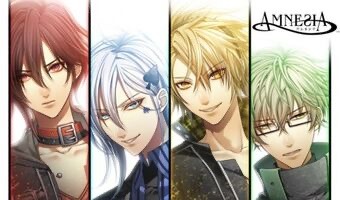
I’d say this is another classic in the circle, but there are quite a lot of bad reviews of it, so why am I recommending it? 1. The art again is pretty top-notch for a reverse harem anime (Loads of Ikemen) 2. The OP Zoetrope is actually really good.
Plot: MC wakes up with no memories, goes on a journey to regain memories whilst meeting handsome guys.
Reason for recommendation: Thought the plot sounds pretty cliche (Well, ok, it is), the story turns out to be a whole lot darker and deeper. Each male lead has their own ‘difficulties’, and as a whole it just made an impact on me, as in I wanted to buy the video game after watching the anime.
The only thing: The Plot may seem jumbled and inconsistent due to it being adapted from an otome game, and the story does not reach a conclusion (That’s probably why there are a ton of bad reviews). There are elements of romance, but it’s not as strong as some other anime e.g Diabolik Lovers.
Akatsuki no yona

Another classic whoooo! Artwork: great, Music: hmmmm, eh? (For me at least, OPs and EDs are pretty important to me).
Plot: Princess finding mythical dragons (ikemen) to save her country.
Reason for recommendation: PLOT, there’s an actual PLOT forgoodnesssake! Yep, there is actually logic behind the events that occur, and there are reasons for each guy to like her (they don’t just fall in love with her magically). There is character development especially for the MC, it’s amazing really. The world the story’s set in is quite unique as well - historical + mythical dragons.
The only thing: Well, you have to bear with the MC, she is quite selfish and ‘spoilt’ at the beginning, and I guess in some ways, it is quite slow to start (romance aspect, character development).
Kamigami no asobi
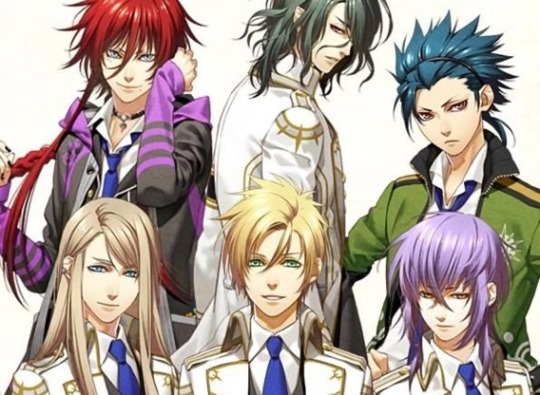
This one probably doesn’t class as a classic, but I throughly throughly enjoyed it. Art: Again, amazing ikemen, Music: Can’t quite remember but does it matter?
Plot: Magic sword transports MC to a different world with roman gods at school.
Reason for recommendation: Plot successfully attacked all my sweet spots: Isekai, high school, roman gods. We have another MC with character and her own personality. Originally rather ‘mundane’ plot turns slightly dark as the anime goes on, and the male leads are not all generic, due to the fact that they are based of the roman gods. You get to learn some mythology as well! There is some actual true romance in it as well (Which is a strange thing to say considering it is a reverse harem anime)
The only thing: One season!!!! WHY????? I need more! (Get the video game) uhh.
Hanayaka nari waga ichizoku kinetograph

Like Amnesia this is another anime with quite a lot of bad reviews, so why am I still recommending it to everyone? I don’t know to be honest... I just stuck in my mind. Art: IKEMEN, music: Can’t remember, probably meh.
Plot: Maid MC working in big mansion, serving the young ikemen masters in the Taisho era.
Reason for recommendation: I’m genuinely still wondering why... 1. It’s set in an historical era which is quite fascinating. 2. Ikemen???? I don’t actually know, but it just keeps popping out whenever I think of reverse harem! Am I into guys ‘bullying’ the MC?
The only thing: MC is a weak character compared to the MCs in the other recommendations. Some of the ikemen get on your nerves due to their arrogant behaviour. (See, I don’t actually know why I’m recommending this, it’s just good in a weird way)
Hakuouki
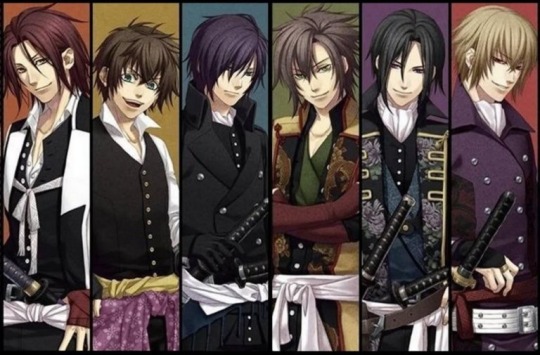
This is a definite classic, and one I have a very strange connection to. Art: I don’t even need to say anything, music: pretty good.
Plot: MC searches for her missing father disguised as a guy, and ends up living with the shinsengumi. (Very very abbreviated plot)
Reason for recommendation: Haha, so this is the story of me and this anime. I actually watched it three times before actually finishing the first season. First time I only made it through the 1st episode before dropping, 2nd time made it through 3 episodes... Yeah, and yet now I’m recommending it. The plot goes from Eh? To OH MY GOD WHAT IS THIS really really fast. (Don’t want to spoil anything but there are vampires in the edo period). Storyline is very important and heavy here, it sometimes requires some understanding of the policial ongoings during the edo period. Don’t get me wrong though, there is romance in the anime, and gaaaahhh the whole thing’s just sad.
The only thing: The romance is slow, you won’t see it right away despite there being so many ikemen hanging around. The MC is also slightly weak at the beginning BUT she powers up quite drastically in terms of character as the story goes on.
Yumeiro Patisserie
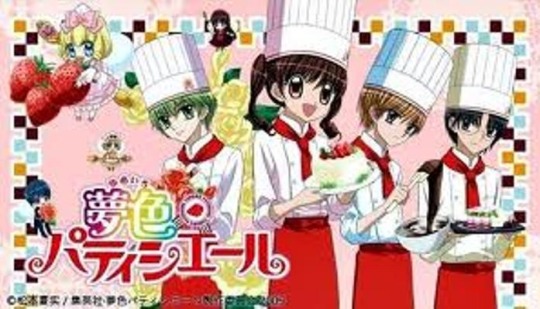
Slightly old anime aimed at younger audiences, but it’s just too cute! Art: hmmm, not as ikemen as the others but Cute, Music: can’t recall anything.
Plot: Clumsy MC who loves desserts gets accepted into prestigious baking academy.
Reason for recommendation: Again, plot. Can’t say this enough really. It’s an upgrade sort of anime where the MC goes from terrible at baking to... well, amazing at baking (Sort of similar to a baking version of shokugeki no Soma, though Soma was already rlly good at cooking). Interestingly enough, the Male leads dislike her at the beginning, but through the MC’s effort and quirky personality fall in love with her. The whole anime is generally really cutesy and healing.
The only thing: It’s aimed at younger audiences, so MC starts out at 14 and grows up. There are a LOT of episodes, so if you are older, you may require some patience.
A list of reverse harem that you may also want to watch
1. Uta no prince sama (Not enough romance for my liking)
2. Brothers conflict (too many brothers?)
3. Dance with devils (I dunno, the singing in it is kind of off-putting)
4. Meiji Tokyo Renka (The MC and plot are both strangely lacking?)
5. Nil Admirari no tenbin (Hmmm... the plot is slightly distracting)
6. Magic kyun renaissance (How do I say this? Just not memorable)
7. Kenka banchou otome (Just cringe)
15 notes
·
View notes
Text
THE DIFERENT CYCLES OF NOSTALGIA FILTER
Most of the nostalgia towards the past is based on Nostalgia Filter. The good stuff is remembered and the bad stuff ignored, forgotten or not even taken in account. When it's about a time period Two Decades Behind people will be nostalgic for it because they experienced it themselves, but from the viewpoint of a child or a teenager, when they didn't have to worry about all the adult stuff that depresses them nowadays, because the grownups took care of all that: taxes, work, bills, tragic news events,... If the nostalgia is about a time period people didn't directly experience themselves the romanticism is even more rampant. People will base their rosy posy image of that time period on stuff they have seen and read in books, comic strips, cartoons, TV series, films, old photos and/or fond memories of older family members. Usually they aren't aware that many things they now take for granted didn't always exist back then or were still considered highly controversial.
The glories of Ancient Greece and Ancient Rome where the cradle of philosophy and science started, everyone is able to enlist in the army (well, if you weren't a woman or a slave, of course) and see the world while doing so. You can go and enjoy watching Olympic Games, a play in the theater or watch exciting gladiator battles in the arena, philosophers like Socrates, Plato, Aristotle and Virgil are respected as pillars of their societies, and people were opened to sex and LGBT as opposed to the close-minded Christians in later centuries. Not taken in account: class systems, people dying early of diseases we nowadays have proper treatment for, slavery, democracy only for rich upperclass males citizens, bloody battles, Roman military service had to be fulfilled several years! before you could retire and start a civilian life, women having no rights, not even allowed to watch sporting games, xenophobia was so prevalent that would make modern prejudices and bigotry look tame, scientific contributions were more based on superstitions and empirical and weren't always based on logic (see Plato's and Aristotle's works), pederasty was the only accepted form of homosexuality and it was punishable if a relationship did not fit in those criteria (also it was only tolerated in some city and states), Roman sexuality was still arguably patriarchal and not all sexual taboo was acceptable (ie. a wealthy man get away with his slaves while married women were expected to be faithful, oral sex was considered shameful).
The thousand years of Chinese dynasties up until Republic was the time where people dressed in beautiful colorful haifu with good etiquette and manners, scholars were appreciated, education was valued as opposed during the Cultural Revolution, the Tang Dynasty was the golden age of prosperity and where women has more rights than any other periods. Not taken in account: the Confucians were oppressive against the lower social classes, the caste system, education systems were corrupted with many scholars and students were promoted based on bribes rather than actual skills, women were still considered inferior in the Tang Dynasty, the royal court were so deadly and decadent that would make the place in wuxia media look tame, slavery, the rebellions and civil wars (ie. The Three Kingdoms, An Lushan Rebellion, Taiping Rebellion) that were very common that cost million of lives that went unheard of and resulted in many famine and diseases that led to cannibalism, footbinding was practiced since the Song Dynasty, xenophobia was prevalent including against their sister countries like Japan and Korea.
The Middle Ages are usually romanticized as a glorious past with chivalrous knights fighting for the honor of beautiful princesses, proving their worth in tournaments, stuffing themselves at royal buffets with the kind old king, and defending castles against malevolent invaders. Not taken in account: The Plague, wars, mercenaries and soldiers plundering farms and villages, filthy streets, people dying at a young age because of insufficient knowledge of diseases, the injustice of the feudal system, monarchs and the Catholic Church being oppressive towards people with other viewpoints, high illiteracy, people executed and tortured for audience's pleasure and often without anything resembling a fair trial, women considered being lesser in status than men, famine whenever harvests failed... Ironically, the part that was arguably good, the Byzantine Empire (with its extremely high literacy and such luxuries as running water) is usually overlooked or completely ignored.
The Renaissance and The Enlightenment are the time when society finally got out of the bleak, primitive and God fearing Dark Middle Ages and gained wisdom by discovering a lot of stuff. Kings and queens never looked more magnificent. Artists and sculptors painted the finest works and humanists, philosophers and Protestants learned humanity to think for themselves. You could enjoy a Shakespeare play, listen to baroque classical music or have a swashbuckling duel. Not taken in account: A lot of new thought and discoveries in the field of science were very slowly adapted into society. Mostly because a lot of royals, religious authorities and other government officials suppressed these "dangerous" new ideas. Compared to those "primitive" Middle Ages more people have been hanged or burned on the stake for their beliefs and/or on the assumption that they were witches during the 1500s, 1600s and 1700s than in the centuries before! The Reformation and Counter-Reformation divided Europe and caused many casualties. All the great books and art works created during this era were only enjoyed or experienced by the very rich. Wars still ravaged Europe, colonization exploited other continents, slavery became a real industry and absolutism made the monarchy and nobility so powerful and decadent that they didn't care about the lower classes. Duels weren't glorious at all, just a matter of killing off your opponent.
The Golden Age of Piracy is one big adventure where you could go on a boat trip with pirates and have fun attacking other ships, taking gold and bury or search for treasure on some Deserted Island. Men were real men with a Badass Beard and cool looking eye patches, hooks for hands and wooden legs. Not taken in account: scurvy, people forced to do what their captain told them, your ship being attacked by other ships and losing, keelhauling, loot just being spent instead of buried, anti-piracy laws could get you arrested and hanged, storms could destroy your ship, all the cool looking eye patches, hooks for hands and wooden legs were just practical solutions for grievous injuries suffered during fights, and the fact that most of the Caribbean economy was reliant on the slave trade. There were also plenty of brutal attacks on helpless villages, indigenous communities, plantations, civilian ships, and even colonial settlements. In addition to helping themselves to everything that wasn't tied down, pirates would also torture, murder, enslave, and/or rape men, women, and children indiscriminately just for their own sick pleasure.
America's Wild West is a fun era where you could roam the prairie on a horse, visit saloons and shoot outlaws and Indians. Not taken in account: slavery was not abolished until deep in the 19th century and still going on in many colonies or remote place in the American South, cowboys took care of cattle and didn't engage in gun fights, gun violence was just as illegal as it is nowadays and could get you arrested by local sheriffs, outlaws could actually remain on the loose for several years, Native Americans being massacred by white settlers and armies, black people having no basic human rights, The Ku Klux Klan was a respected organization...)
The mid-to-late 19th century and early 20th century were a classy time period where everybody was impeccably dressed and had good manners. You could take a coach ride or (later on) test the "horseless carriage", read some of the greatest novels in history, listen to the first records or even the great Caruso in person, admire the wonders of electricity and enjoy a world still untouched by modern industry. Life in the colonies was even more fun because you so many countries were still unexplored territory and the ideal place for adventure. Not taken in account: Victorian values were dominant, women couldn't vote, poor people couldn't vote, industrialization didn't have any health, safety or ethical rules to obey, child labor was rampant, workers had no rights, factories were very harmful to people's health and the environment, city rivers were open sewers, upper class had all the advantages upon the lower class, people could be sent to the poor house when they couldn't pay their debts, many novels were just pulp (think of it as the 19th century version of Internet) and music was strictly symphonic, the first automobiles were as dangerous as electricity, colonization was great for white Europeans but not as much for the oppressed native populations of Africa and Asia, animals were still hunted down as trophies, people who looked different were exploited in freak shows and circuses for spectators to Come to Gawk.
The Interbellum (1920s and 1930s): Between the two world wars, life was great. Everybody went to night clubs and/or revue theaters where they could enjoy great jazz music, girls and comedians. Movie theaters were a great place to be, because fantastic cinematic masterpieces were made. On the radio you could great music and serials, and newspapers published the best and most engaging comic strips ever printed. Not taken in account: From 1920 until 1933 alcohol was prohibited in the USA, so having an alcoholic drink was impossible without getting arrested or dying because of bad homemade brew. Crime was able to organize itself in a way that will probably never get untangled again. Many people got murdered in gangster violence. Jazz music was initially seen as "barbaric" just because it was made by blacks, and it had to be adapted to symphonic music to make it well-known. Hollywood in its early years was subject to more scandals than ever since, leading to a industry-wide censorship that lasted until the 1960s. The Great Depression between 1929 and 1940 caused major unemployment and poverty in many civilized countries, also forcing quite some people to start a life in crime. The "Dust Bowl" generated a desertification of the Midwest. Germany was particularly struck hard, because the country was still paying huge war debts to other countries, causing mass poverty and the ideal atmosphere for Nazism to gain voters. Many countries during this time period suffered under either Nazism, Fascism or Communism. From 1933 on Jewish, homosexual, Romani and left wing people were already persecuted in Nazi Germany, at the same time disagreeing in anything with Stalin meant a one-way ticket to Siberia. War was already brewing in Europe and the Far East, when Japan invaded China and South East Asia. Many countries were still colonies, which wasn't a great deal for the natives there. Afro-Americans were still second class citizens and the Ku Klux Klan was still quite powerful in many political circles.
The '40s and World War II, the time where the entire world was united against a common evil foe and soldiers could still fight a just cause. Everybody worked together to defeat the Nazis or Japanese, while enjoying great Hollywood films and jazz and big band records on the radio. Not taken in account: Not everyone was united against the Axis. Numerous people (even Lindbergh and Ford) didn't consider Nazism or Fascism anything bad or felt their country should stay neutral in the war. During the occupations many people on both sides were arrested, deported, and/or murdered. People couldn't trust anyone, because your neighbor might be a Nazi collaborator or a spy who would turn you in to the authorities. The Nazis banned American and English music and films in Europe, so you could get in big trouble if you tried. Also, you know, there was a big war on. Millions of young soldiers were drafted and died on the battlefield, cities were bombed and occupied by enemy armies, you could die any day, shortages were rife.
The '50s: The last truly great time period in history. Music, films, politicians were nice, clean and decent. There was a general optimistic feeling about the future, exemplified in sunny fashions, interiors and technology. The youth enjoyed some great rock 'n' roll on their transistor radios and the early TV shows show how happy and pleased everybody was. Not taken in account: the Cold War, the Red Scare, anti-communist witch hunts, the Korean War, the French Indochina War, many European countries tried violently oppressing the inevitable independence of their colonies, Afro-Americans were still second-rate citizens in the USA and had to fight for human rights, homosexuals were forced to keep their sexual identity silent in many countries, the traditional role of women as housewives was still encouraged in many Western countries, a lot of music in the hit parade was still the bland, square, formulaic and sappy crooner music popular since the 20s, adults were scared of early rock 'n' roll and actually did everything to suppress the youth from listening to it and becoming teenage delinquents, the TV shows and films of that decade were so escapist that they ignored every controversial element.
The '60s and The '70s, a great time when everybody was a beatnik or a hippie and enjoyed fantastic rock music, marijuana, LSD and free love. People chased bad guys with their own hands with cool funk and disco music playing in the background. The young demonstrated for more democratic rights and everything changed for the better. Not taken in account: the older generation looked down upon hippies, the Vietnam War cost many lives, The Cuba Missile Crisis nearly caused a nuclear war between the USA and USSR, Afro-Americans still had to fight for civil rights, just like today there were just as much idealistic but naïve demonstrators who merely wasted time smoking pot instead of actually doing something, drug casualties were just as rampant back then as they are today, people took the law on their hands because of the alarming crime rates, not helped by the extreme corruption of police forces, psychedelic rock, funk and disco are now confined to sit in the shadow of both rock-and-roll and modern pop music, to the point that for decades, these were considered as the most cheesy genres created by man, [[not all demonstrators were pacifistic in their approach and it's an open question whether everything actually changed for the better.
The '80s: Oh yes. A great decade for pop culture after the sordid '70s and before everything went to the gutter in the '90s: Everybody felt a bright future coming along, as demonstrated by good TV shows, groundbreaking technology, computers and videogames, colorful clothing, simple yet catchy pop music and finally a TV channel that showed your favorite bands 24/7. The Cold War came to an end, the Berlin Wall and Apartheid fell. Not taken in account: The early 1980s had many people fear the Cold War wasn't going to end well. The Latin American debt crisis. President Reagan wanted more nuclear missiles in Europe, envisioned the Star Wars defense system and the "Evil Empire" speech reflected the "Red Scare" at a time "the Bomb" was still making everybody nervous. The Cold War, Berlin Wall and Apartheid did fall, but only near the end of the decade. Unemployment and economic crisis were a huge problem in many Western countries in the early years of the decade and the high speculation led to a bubble which fatigued in 1987 and burst in 1989. AIDS caused many victims because governments were slow to inform the general public on this disease as most people at first dismissed as just a problem for blacks, gays and drug users. TV shows and movies were extremely escapist and PCs and video games were prohibitively expensive. MTV did bring music videos on TV, but the downside was that how a pop star looked and danced became more important than the music, which was now created by computers, becoming increasingly sappy and repetitive as samples became the norm, becoming a disadvantage for those who still wanted to use actual instruments, chords and tunes. Metal and rap were seen as crime-mongering and even "satanic" as a whole. Also drugs went artificial during this time, turning Florida into a Crapsaccharine World. The nuclear power plant explosion in Chernobyl caused another major fear among people about the dangers of nuclear power.
The '90s and The Aughts: Dude. The Cold War has ended, and though some pesky Arabs (and some nutcases in the West) will try to blow people up and some Central European countries will be at each other's throats, there is peace at last! Outsourcing has lifted the West from the heavy load of manual work for good and turn to technology, and anyways, isn't the Internet wonderful? Society and culture are now free to break all imposed boundaries: Music has become more authentic with the arrival of rap, hip-hop, grunge and pop-punk. TV and movies now address modern issues instead of being stuck in those stodgy 50s and 60s. Politicians at last agree on stuff and generally get along. Whatever. Not taken in account: While a couple of years in the late 1990s were quite peaceful, the years before were marked by the extremely chaotic rearrangement of the former Warsaw Pact nations and the decade after was dominated by the Iraq War and memories of 9/11. The "technological revolution" ultimately never became the boon it was supposed to be: Economically, the exodus of manufacturing jobs forced the middle class to live on debt, which would give way to an economic meltdown by the end of the 2000s while privacy would gradually become a major source of concern as personal data became readily accessible. During the 1990s, the Internet was very expensive and was the province of businessmen and geeks while during the following decade, online downloads and chatrooms became incendiary topics. Grunge and "gangsta rap" were better known at their peak for the demise of several of their stars than for the music while hip-hop and pop-punk would be regarded in retrospective as trashy as the bubblegum pop that dominated the late 90s. By increasingly appealing to the trendy set, TV and film became increasingly shallow. While ideological differences became a thing of the past, politics became more self-serving and conflicts became pettier. As a result, people began to feel a sense of disconnection, which eventually led to the rise of strongly ideological populist movements.
SOURCE:
https://tvtropes.org/pmwiki/pmwiki.php/Main/NostalgiaAintLikeItUsedToBe
EXTRA: IN THE DISTANT YEAR OF 2045.
The New '10s and New '20s : Remember that meme? Do you have a Harriet doll? I need her to complet my My Little Poney: Friendship is Magic and Equestria Girls collection. Do you want to exchange her for my Fluttershy doll? Oh, do you like Lady Gaga? Her music was so deep. “Oppan Gangnam style. Gangnam style. Op, op, op, op oppan Gangnam style. Gangnam style. Op, op, op, op oppan Gangnam style. Eh sexy lady. Op, op, op, op oppan Gangnam style. Ehh sexy lady, oh, oh. Eh, eh, eh, eh, eh, eh”. Oh, i love your funko pop of Baby Groot! “ Gotta get that. Gotta get that. Gotta get that. Gotta get that that that. Boom boom boom (Gotta get that). Boom boom boom (Gotta get that). Boom boom boom (Gotta get that). Boom boom boom. (Gotta get that) Boom boom boom. That boom boom boom. That boom boom boom. Boom boom boom”. Avengers Assemble!
Not taken in account: The Syrian refugee crisis. The burning of the Amazon jungle. Donald Trump as the american president. Jair Bolsonaro as the brazilian president. The Covid-19 Pandemic. Navy oil in the beachs of the brazilian north east. The Brazilian Cinematheque getting closed. Height of murders of LGBTQ in Brazil. Disney monopolizing the american TV an Movie Industry.
@theroguefeminist @ardenrosegarden @witches-ofcolor @mademoiselle-princesse @butterflyslinky @anghraine @notangryenough @musicalhell @rollingthunder06 @graf-edel-weiss @princesssarisa @culturalrebel @irreplaceable-ecstasyy @im-captain-basch @iphisquandary @jonpertwee
10 notes
·
View notes
Text
The Renaissance Used as Symbolism
Animation likes to utilize artworks and literature from the Medieval/Middle Ages era (476-1299) as well as the Renaissance era (1300-1700) due to not only the fact it is part of the public domain (meaning anyone can use it without legal repercussions) but also due to its significance upon the present. Animation tends to make use of the Renaissance as a way to quickly develop characters or settings by showcasing elements that resemble the Renaissance or simply act like they are of that period.
One of the blatant ways animation uses elements of the Renaissance is to name characters after well-known people from this time. The Disney TV series Gargoyles during the 1990s many references to Shakespeare’s plays, and characters are no exception. Creator Greg Weisman introduced characters such as Macbeth, who plays a major role throughout the series as an antagonist. This character is a direct reference to Shakespeare’s powerful tragedy Macbeth (1606).
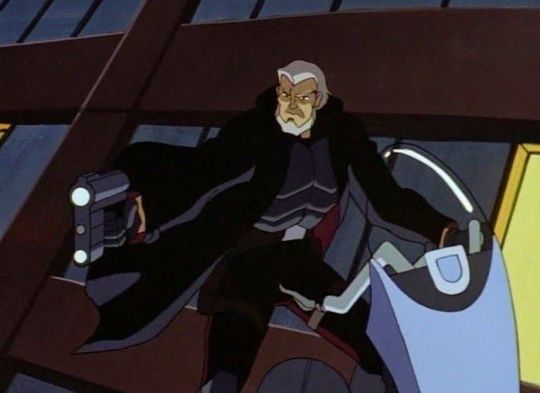
Gargoyles (Walt Disney Animation, 1994), character Macbeth
Along with that namesake, Macbeth acts fairly similarly to the character he was named after. He is very suspicious of everyone he encounters and resorts to violence more often than not. He also deals with the twisted torture of three witches who have watched over his actions during his life thus far. As Weisman is a huge fan of Shakespeare, his references continue, as is showcased during an episode in which the character/mythical spirit Puck is introduced. Puck was a character who appears in Shakespeare’s play A Midsummer Night’s Dream (1605).
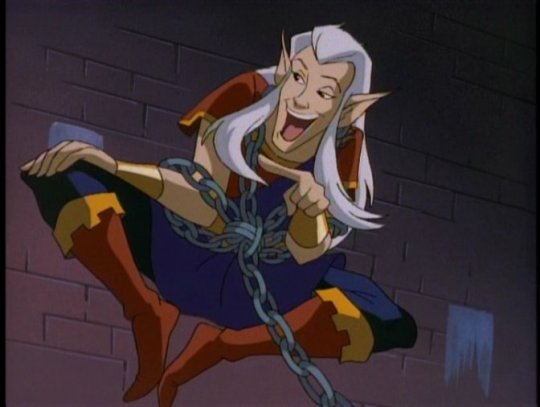
Gargoyles (Walt Disney Animation, 1994), character Puck
Puck is also very similar to the character of his inspiration, and thus is very mischievous to those who try to take control of his magic. What is similar between both Macbeth and Puck is that instead of having to spend a lot of screen time showing exactly what the personalities of these characters is, Weisman instead chose these Renaissance names due to the weight they already had in pop culture. People more than likely expected Macbeth and Puck to act similarly to the way they were portrayed in their Renaissance equivalents and that is certainly true in Gargoyles.
This kind of exposition through previously established, historical recognition is seen in other shows besides Gargoyles, such as Teenage Mutant Ninja Turtles.
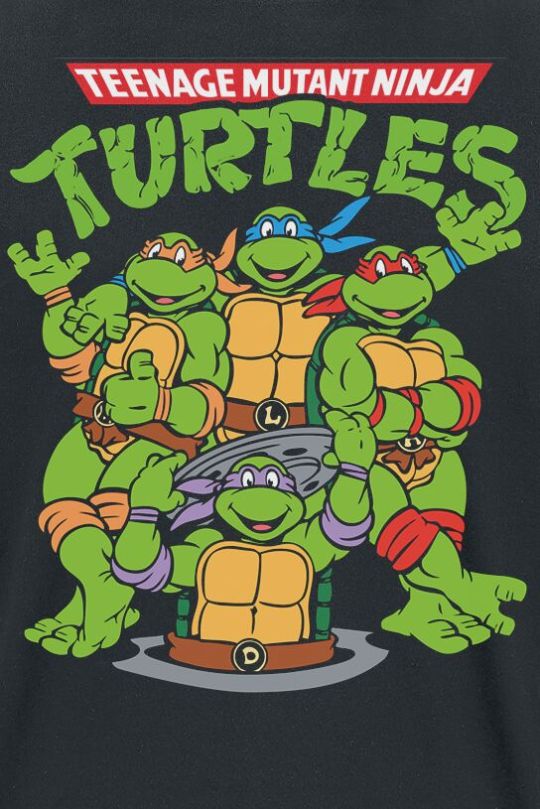
Teenage Mutant Ninja Turtles T-shirt merchandise (Murakami-Wolf-Swenson, 1988).
The four main turtles in this franchise are named after four prominent artists of the Renaissance: Leonardo, Raphael, Donatello, and Michelangelo. While these turtles are more warriors than artists and are vastly different in personality than their namesakes, their names serve a purpose to give them a kind of historical influence to their character that would have been lost if they were simply named “originally” without reference to previous works. Funny enough, the creators Eastman and Laird are history fans and landed upon the idea of the turtles having the name of Renaissance artists by chance (Tucker, “6 surprising facts”). Even though this may have been a seemingly random decision, the creators none the less gave the turtles a meaningful backstory, where their caretaker, Splinter, chose to name them out of a history book found in the sewer. Thus it emphasizes that these names are of important historical figures.
A kind of animation that takes historical recognition to a more interactive level though is the video games of the Assassin’s Creed Franchise. The games in which the most Renaissance references occur are Assassin’s Creed II and Assassin’s Creed Brotherhood, in which the player travels through Renaissance Italy. Along the way the player encounters characters who are also people from history, such as Niccolo Machiavelli (1469-1527), Leonardo da Vinci (1452-1519), and Rodrigo Borgia (1431-1503). Besides looking like their namesakes, these animated characters also have some of their most notable personality traits.

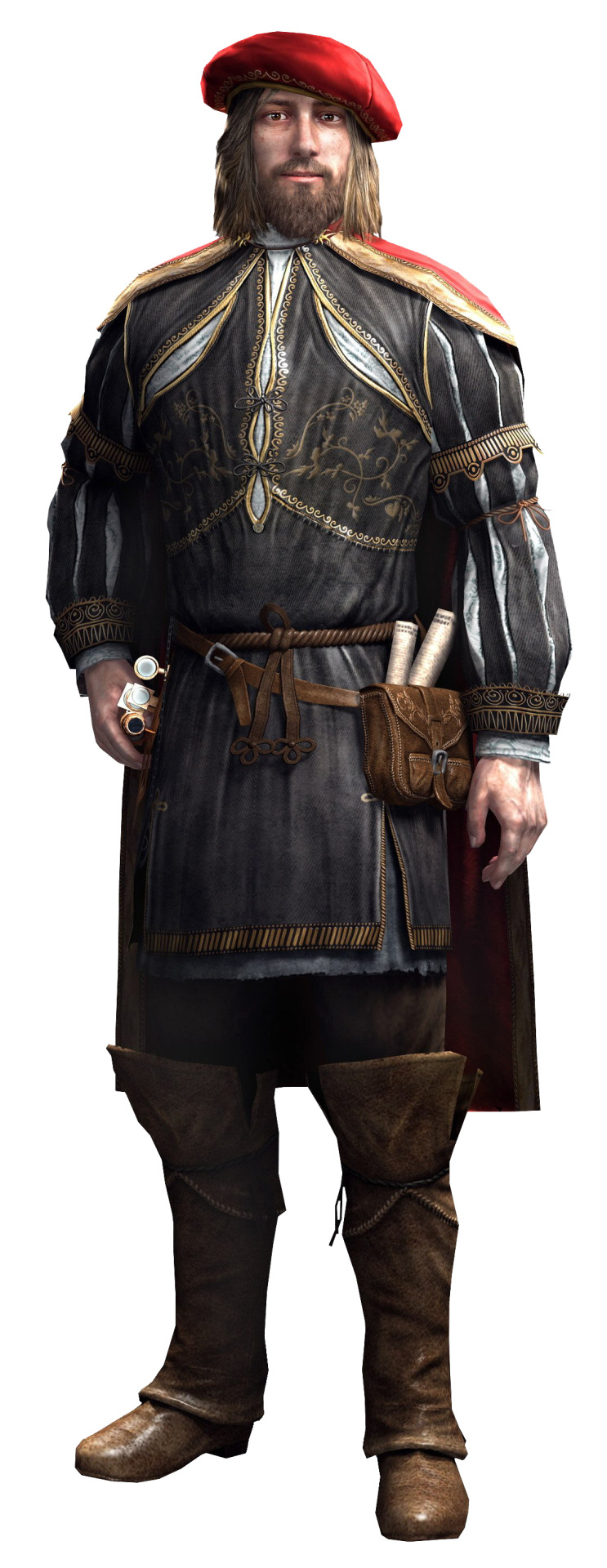

Assassin’s Creed II (Ubisoft, 2009) and Assassin’s Creed Brotherhood (Ubisoft, 2010) characters Machiavelli, Leonardo da Vinci, and Rodrigo Borgia, respectively.
Leonardo da Vinci is particularly interesting as they make him obsessed with inventions which end up aiding the player through the game. This kind of detail did not need to be added, but because it did, players who enjoy history likely would feel more engaged as it would feel as though these characters are living up to their perceived expectations of how they should act. Pop culture has told us that these Renaissance men are extremely complex and cannot be fully understood due to the lack of evidence of their everyday existences. However, providing interactive, animated experiences such as Assassin’s Creed has given consumers a new way to analyze the past and pose questions that will lead to further dialogue (Sheppard, “Historical References”).
Besides being relatable by name, other works can show a clear symbolic connection to the Renaissance through visuals. During one class session, my classmates and I were introduced to an image from Disney’s 1959 animated film Sleeping Beauty in which two kings, the fathers of Princess Aurora and Prince Phillip, are shown talking together throughout the film.
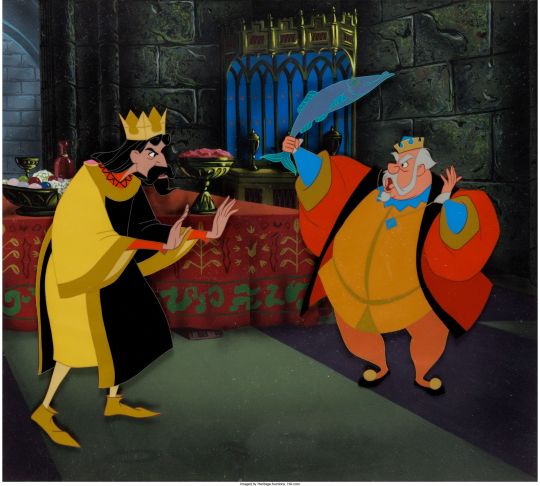
Sleeping Beauty, dir. Clyde Gironimi (Walt Disney Animation, 1959)
The stout king on the right, named Hubert, is shown to be a slight reference to King Henry VIII as Hubert’s stature and clothing mimics the visual look of the Holbein portrait. From the poofy sleeves to the facial hair, Hubert exudes the kind of flair that the Holbein portrait conveys. Artists take these historically recognizable characters into consideration when creating character designs, as it can make a rather complex role suddenly simply to understand. Instead of having him look like a completely original king with no base in historical fashion, the artists went with a design that would instead conjure up this kind of kingly appearance that continues to permeate our society.
One of the last examples that comes to mind when discussing historical recognition is Disney’s 1973 film Robin Hood which tells this classic tale using anthropomorphic characters.
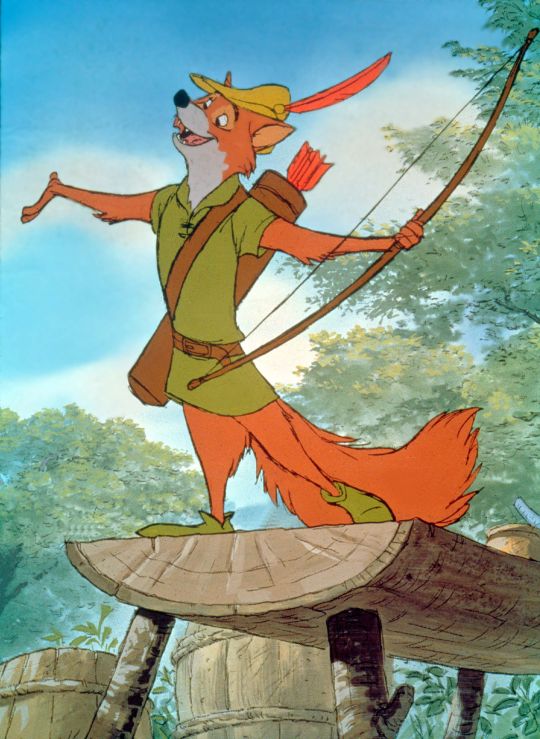
Robin Hood, dir. Wolfgang Reitherman (Walt Disney Animation, 1973)
Besides sharing the title character’s namesake, this fox version of Robin Hood also carries with him the signature bow and arrows that the legendary figure was told to have as his trusty weapon of choice. This Robin Hood therefore is similar to Gargoyles’ Macbeth in that the characterizations as well as the name are integral parts of the way the audience gains an understanding of the characters.
Whether the symbolism in animated media is blatant or subtle, it is important to recognize that imagery and historical figures are and will more than likely continue to be an important part of this medium, as it gives this era a chance to continue to influence the world of today. This is due to the fact that as a society we continue to claim the Renaissance as a crucial era of human history. We believe it should be remembered and built upon, even if our cultural understanding of the true nuances of this era happens to be very skewed into the belief that the Renaissance exemplified perfection in every way.
Sources:
Omar, Mohd and Ishak, Sidin. “Understanding Culture Through Animation: From the World To Malaysia.” Malaysian Journal of Media Studies, vol. 13, n. 2. (2011): 1-9.
Sheppard, Sally. “Historical References in Video Games: The Italian Renaissance.” Academia.edu Database. vol. 1 (2008): 1-6.
Tucker, Reed. “6 surprising facts about the Teenage Mutant Ninja Turtles.” NY Post, (2014).
#reanimatedrenaissance#renaissance#animation#education#derivative#art#cartoons#disney#historicalrecognition#memoryimage#gargoyles#assassins creed#video games#tmnt#robin hood
8 notes
·
View notes